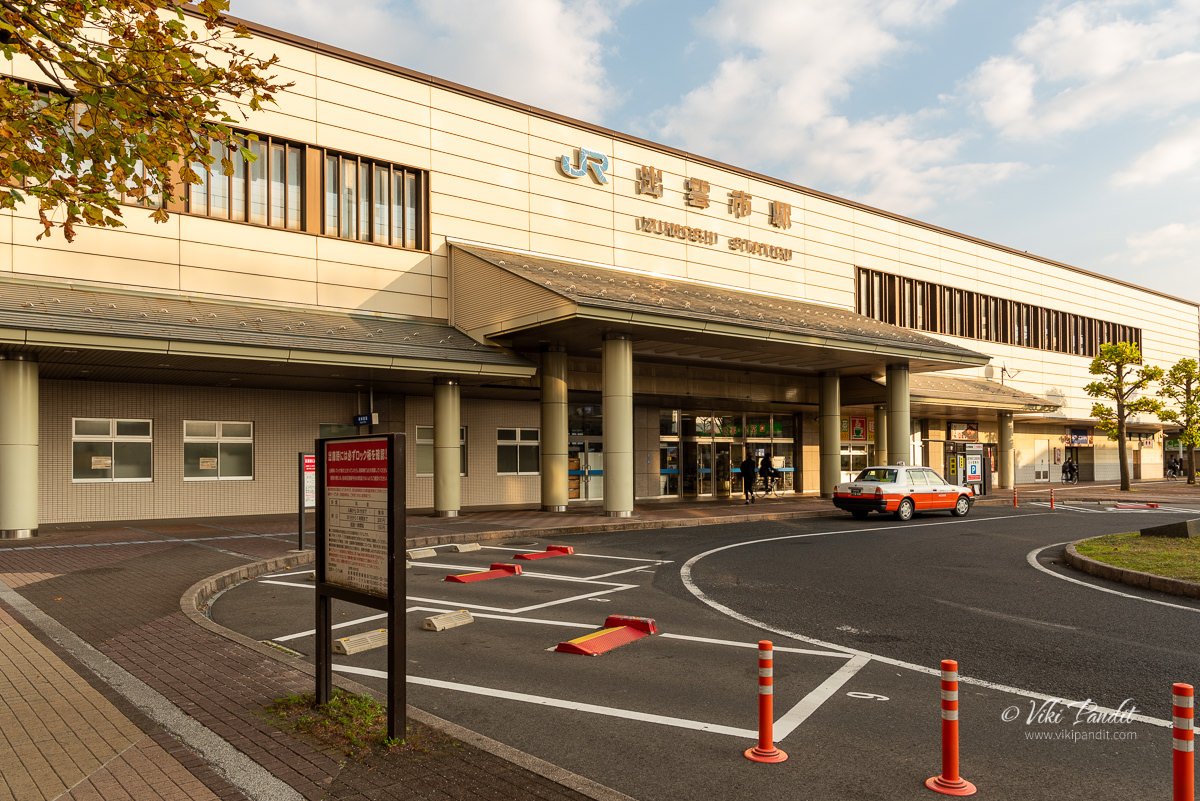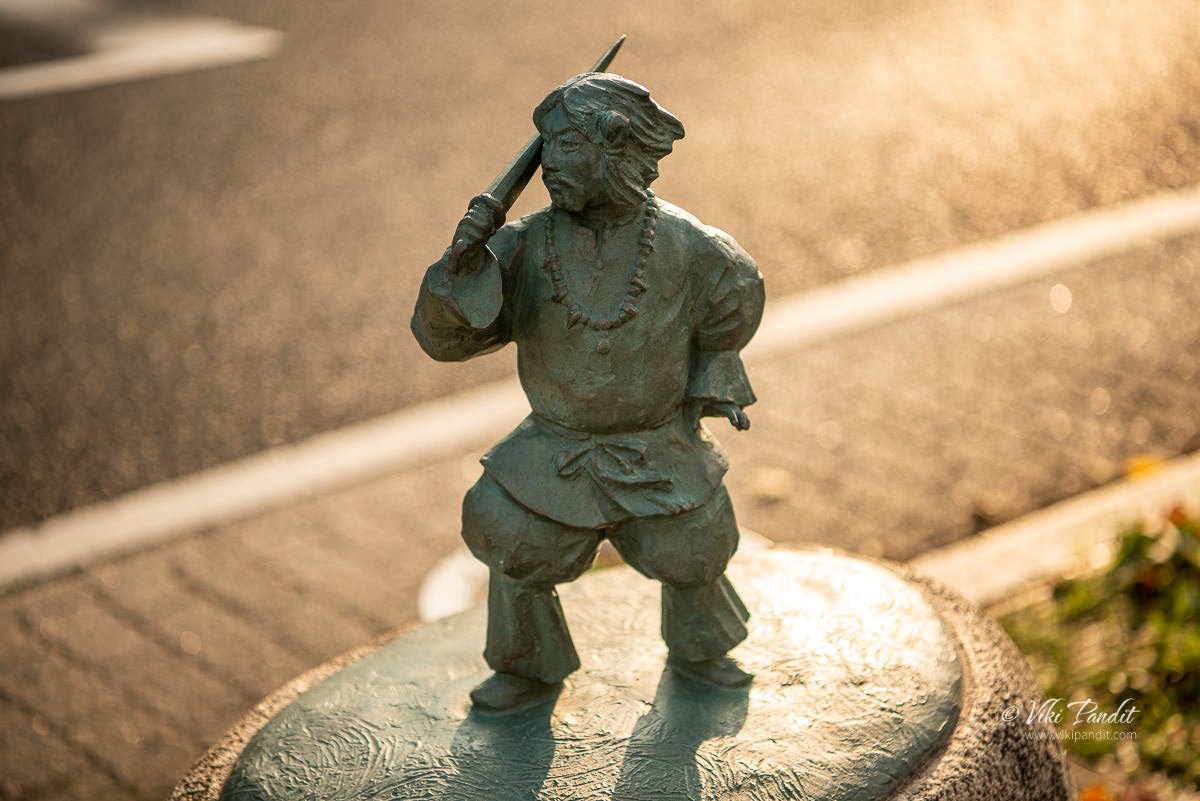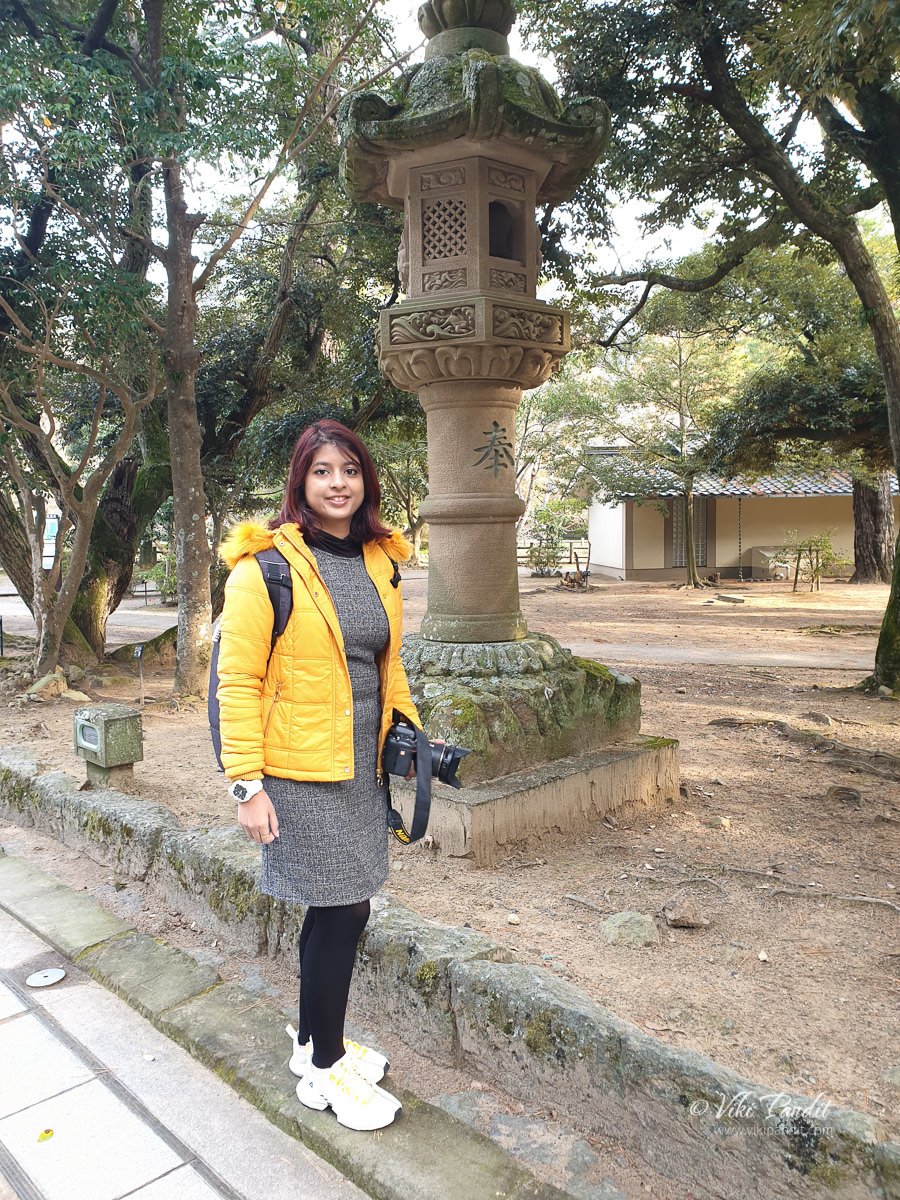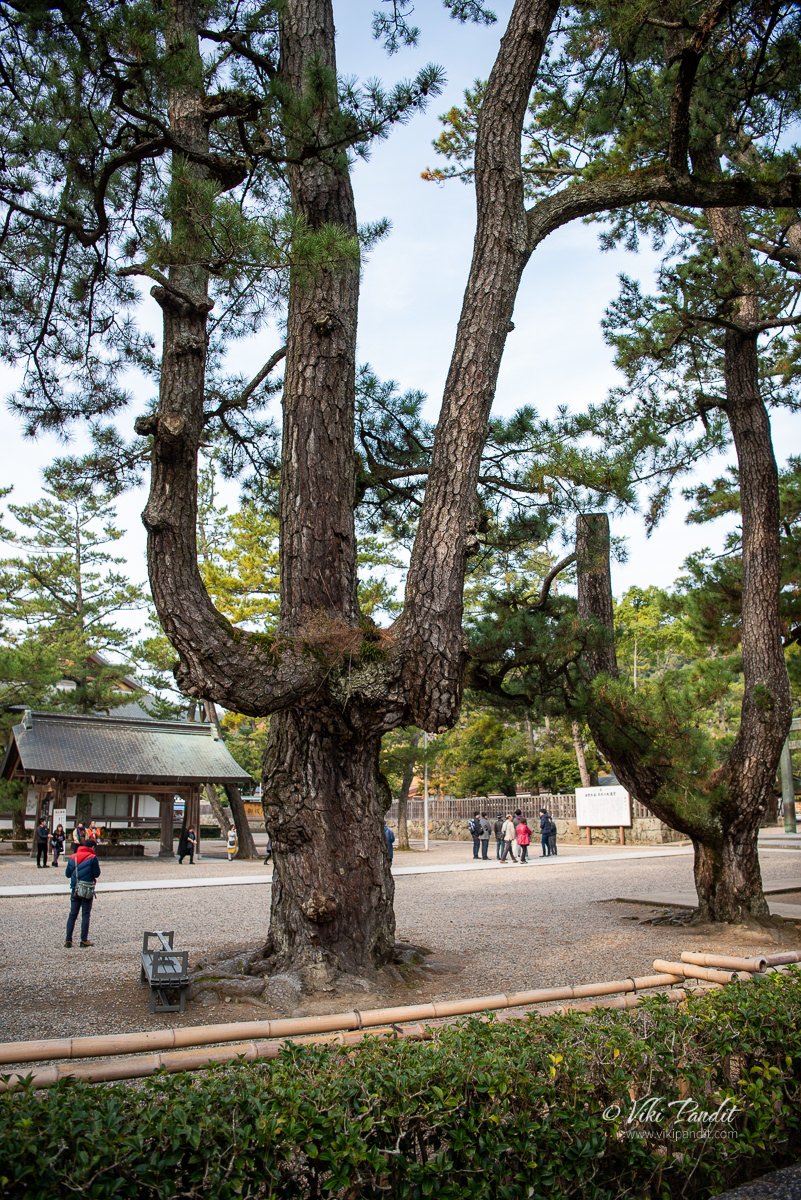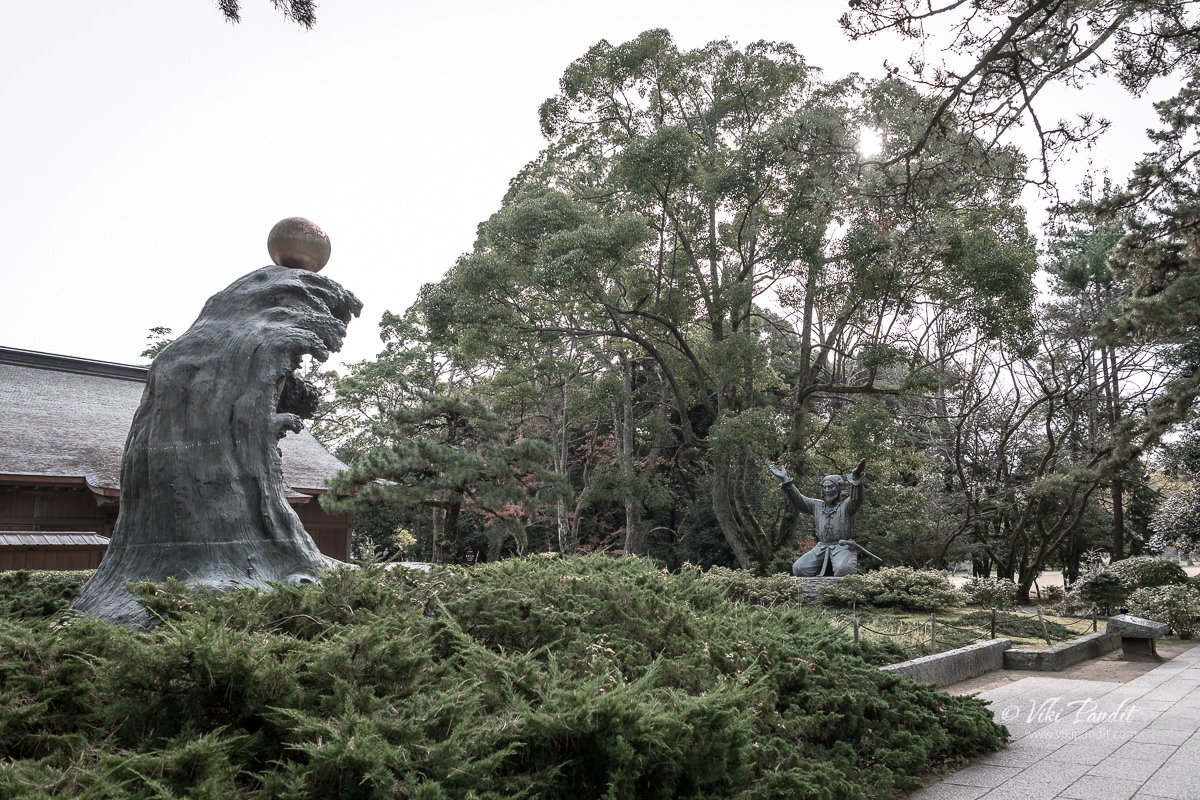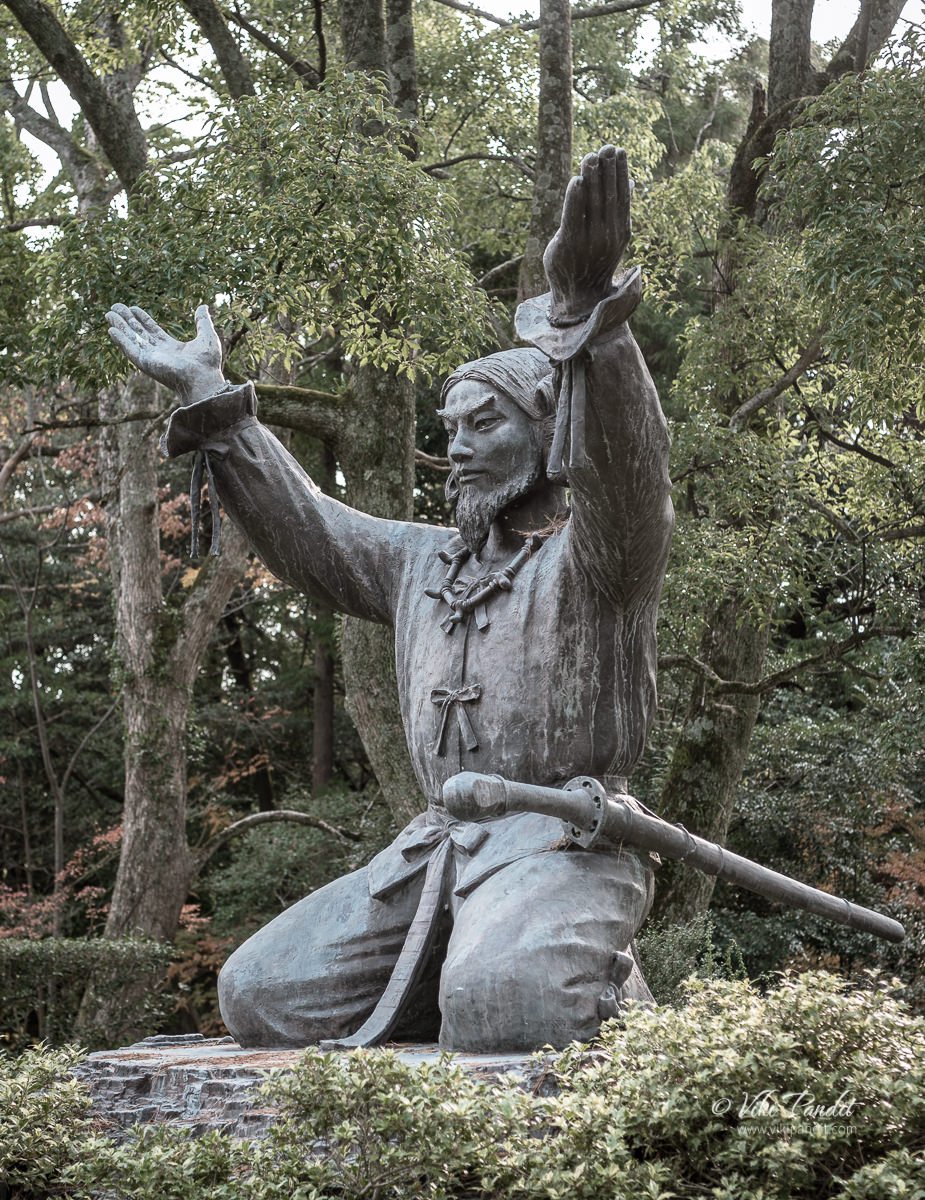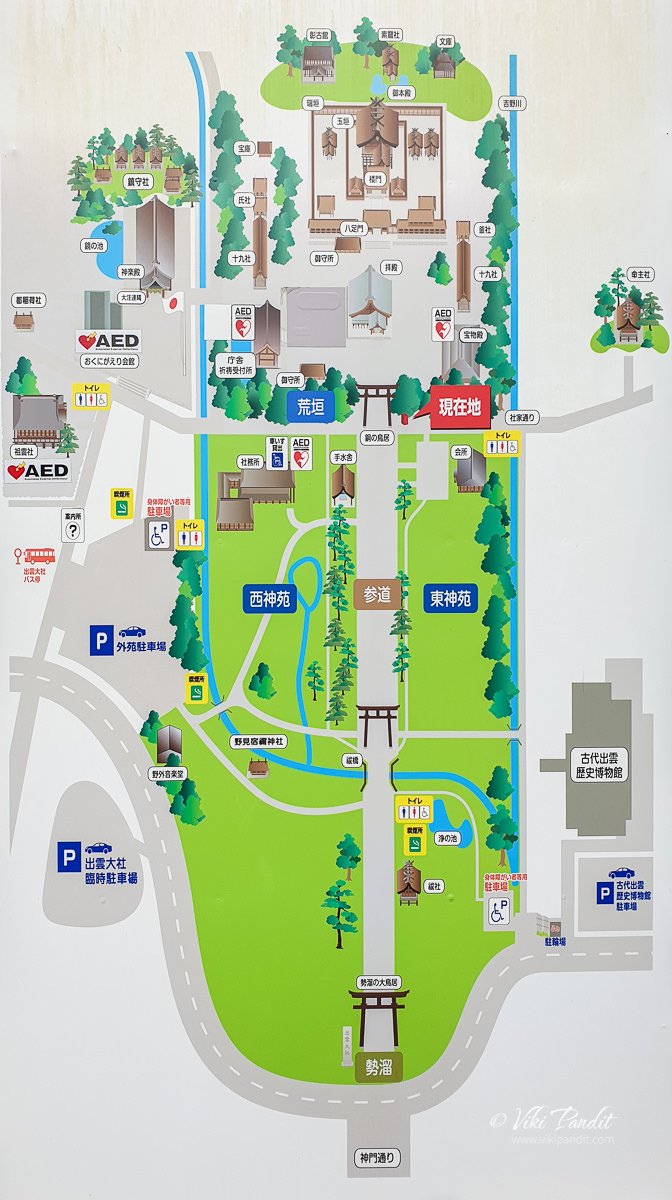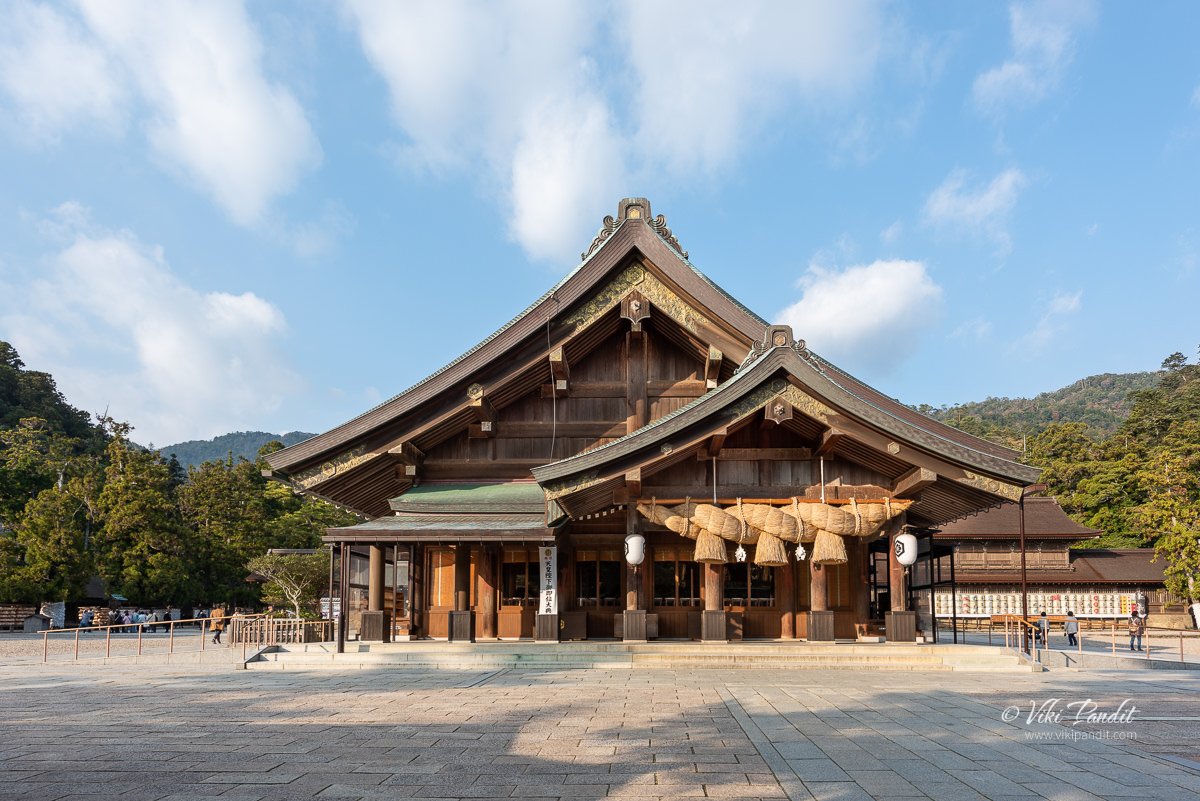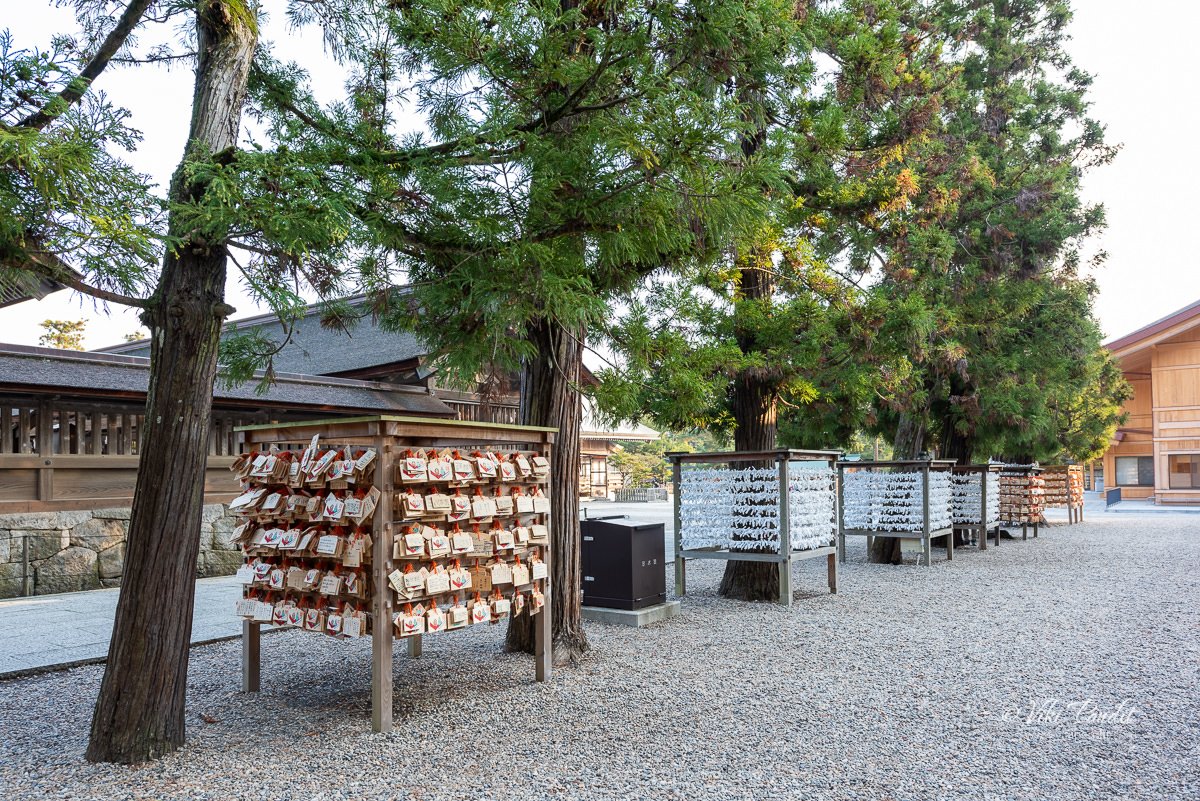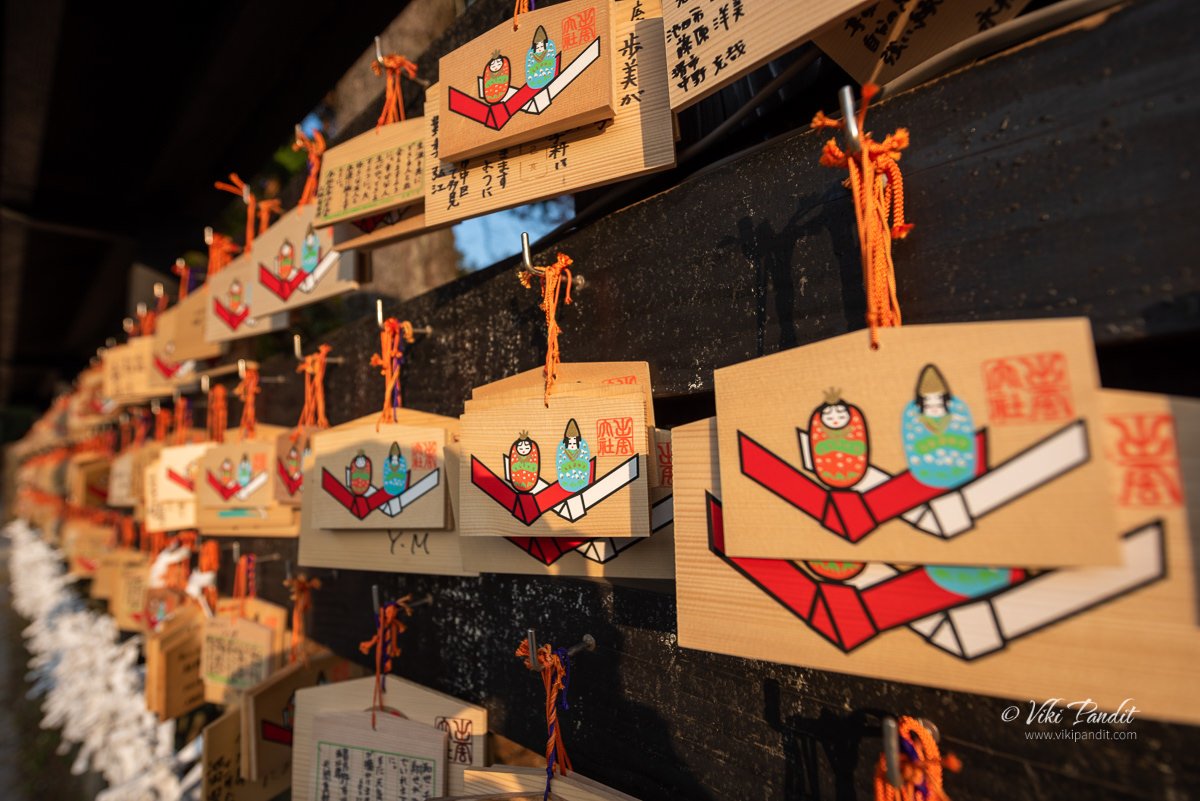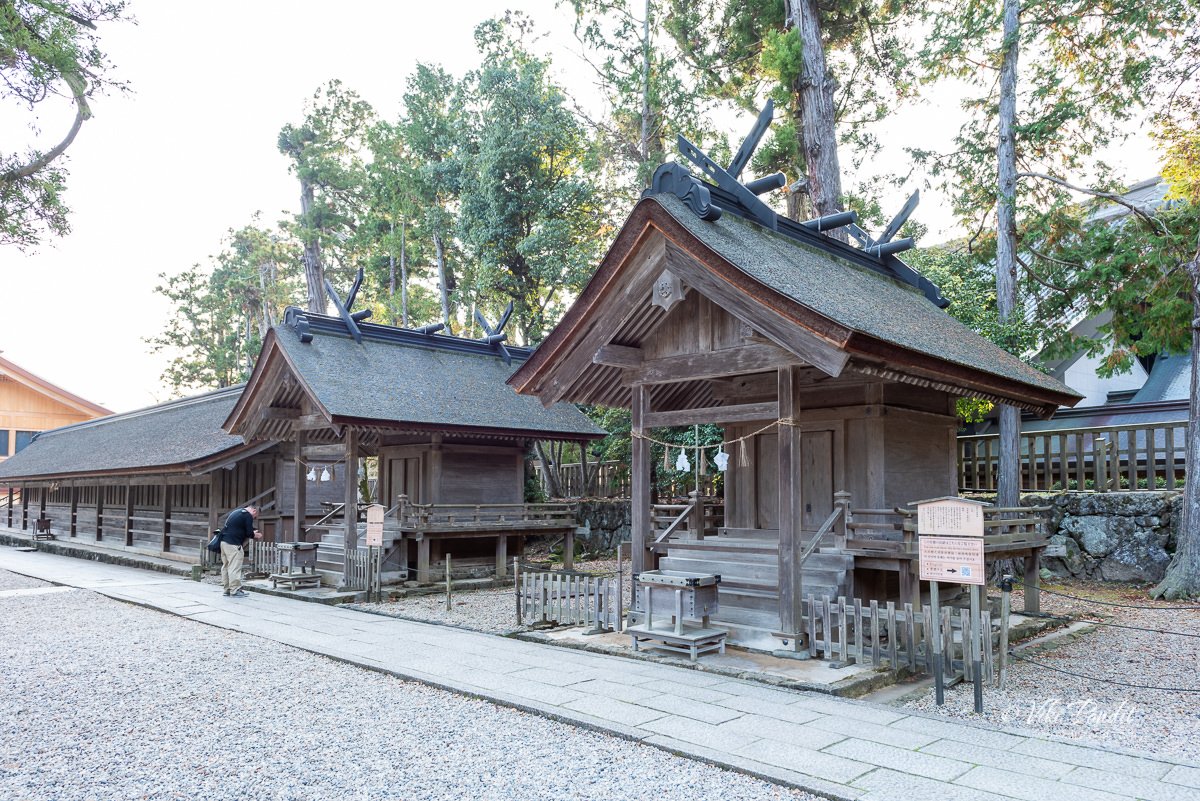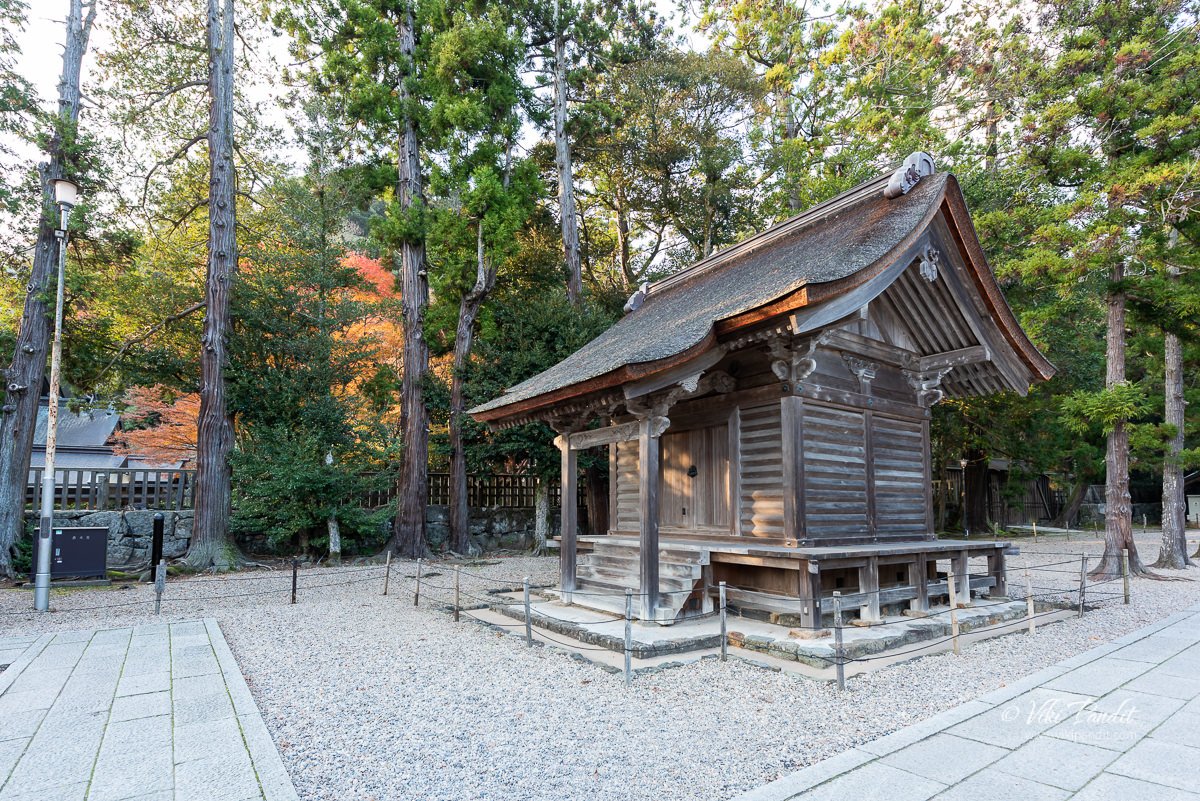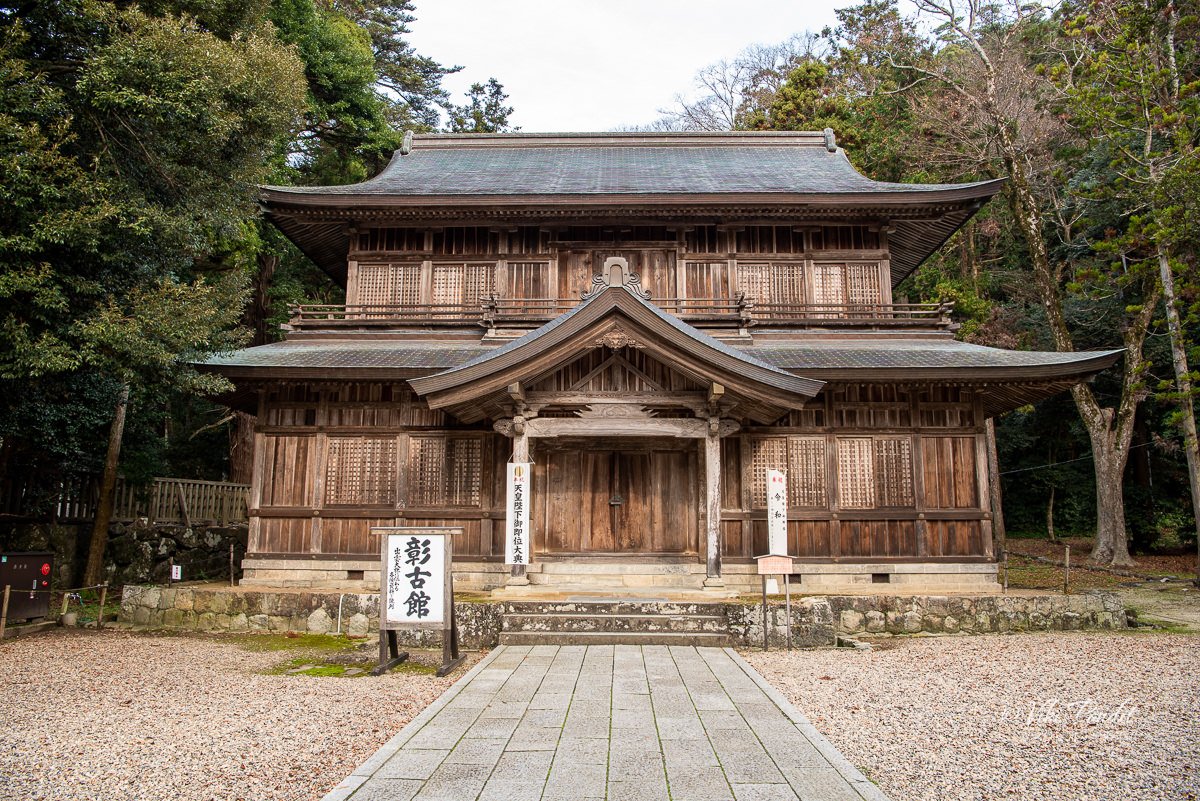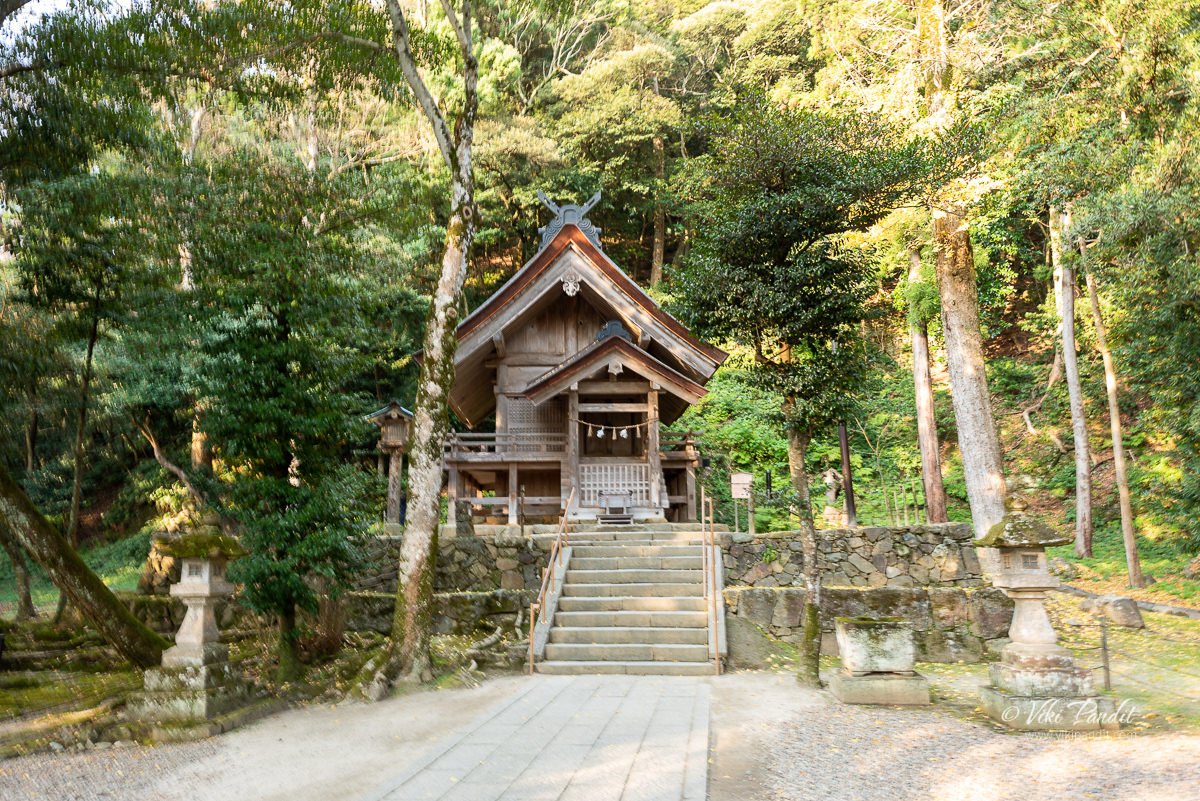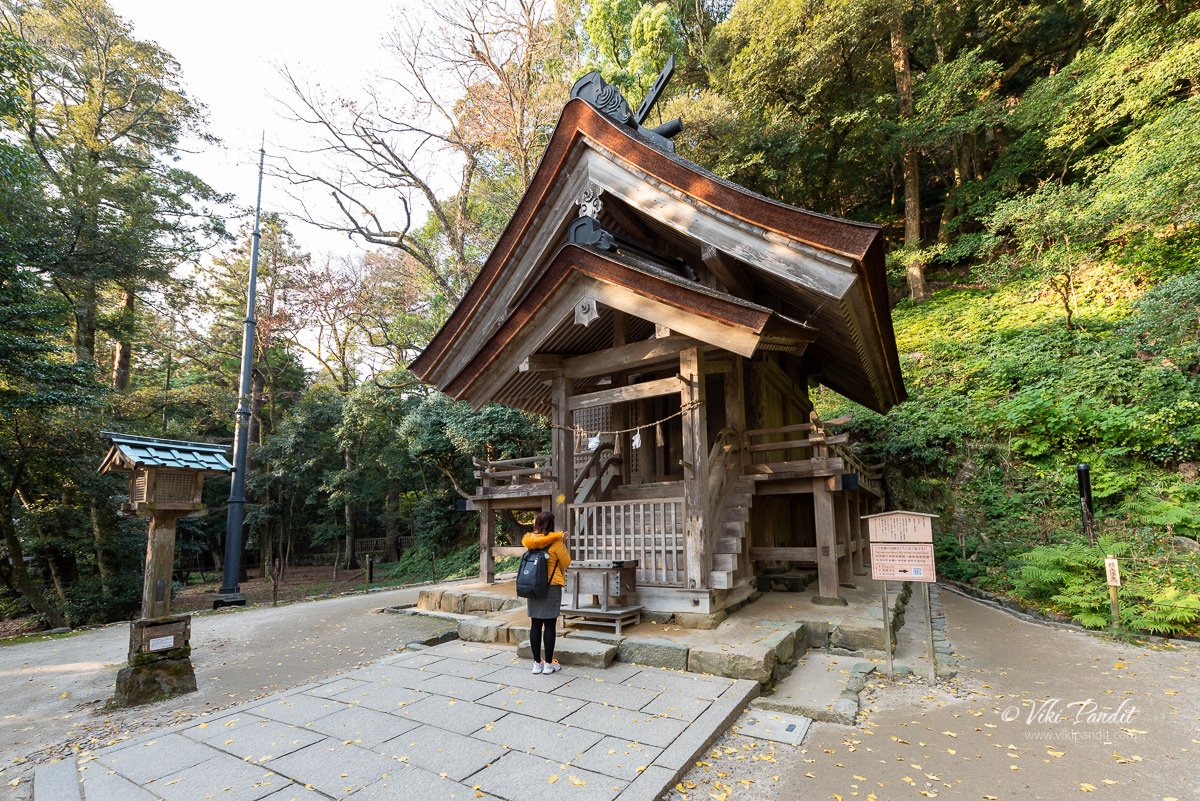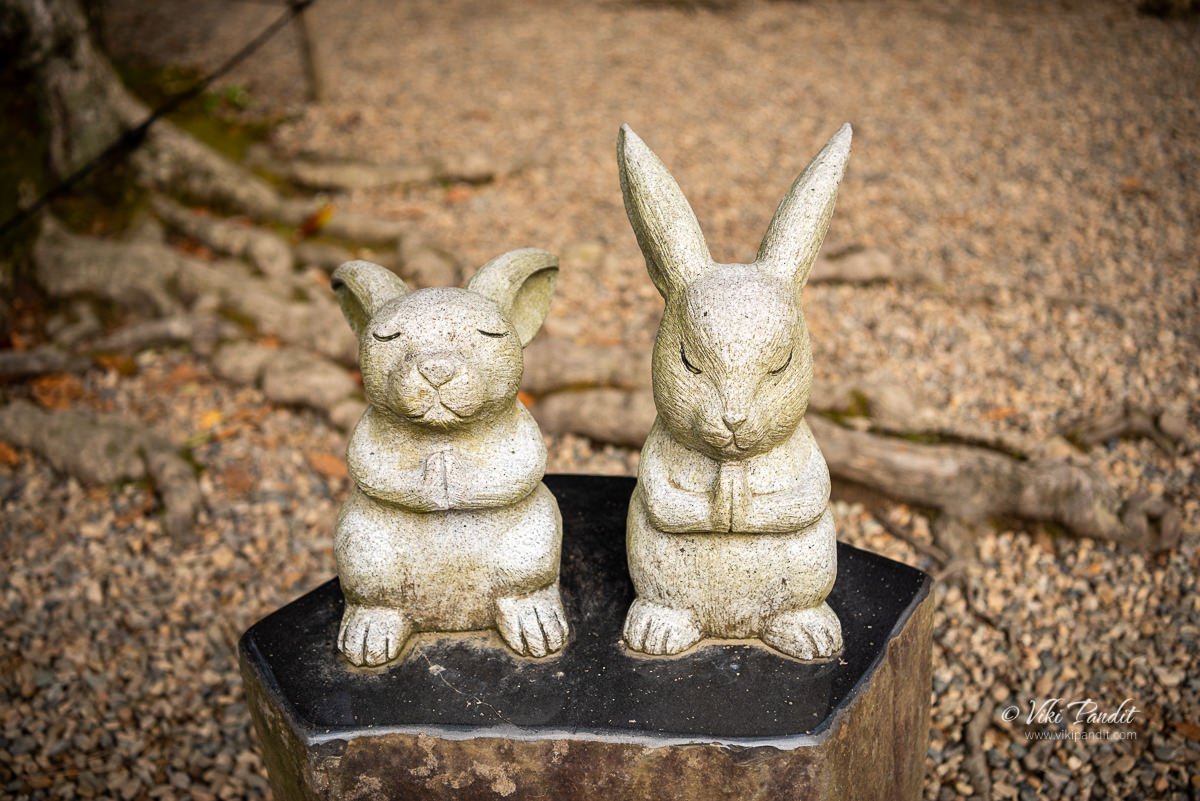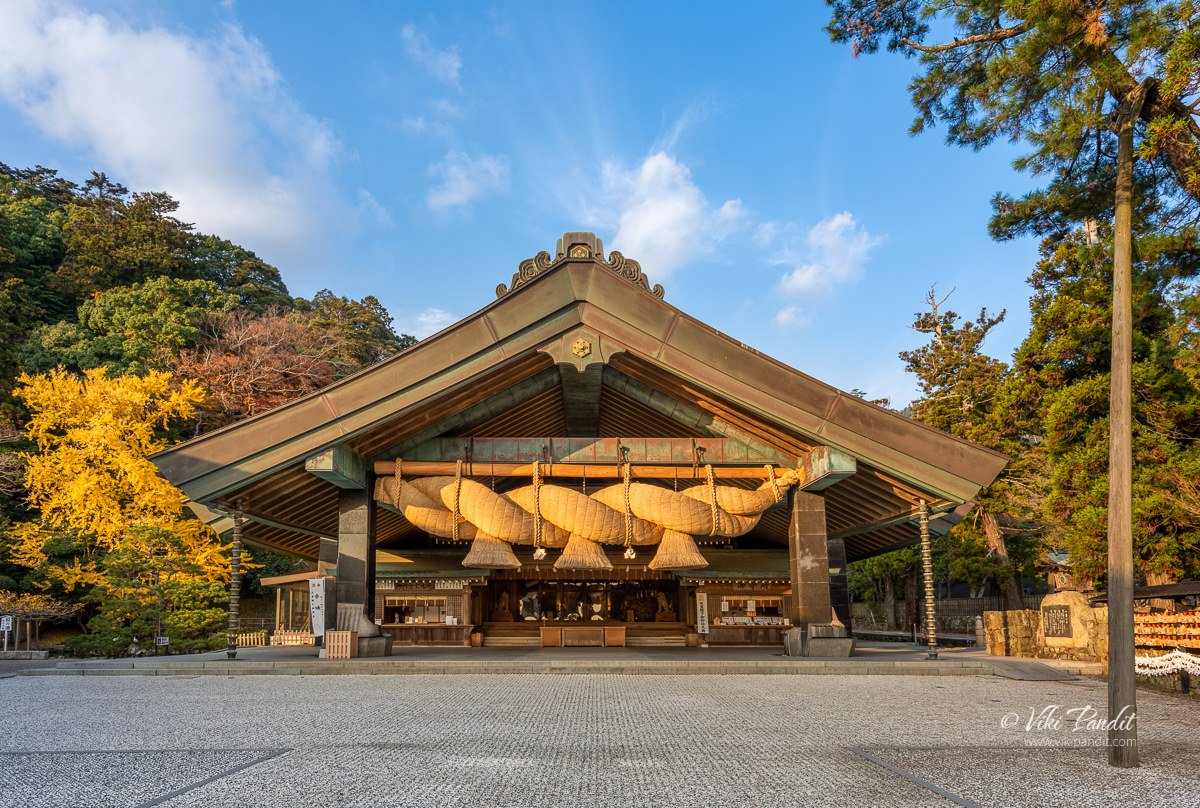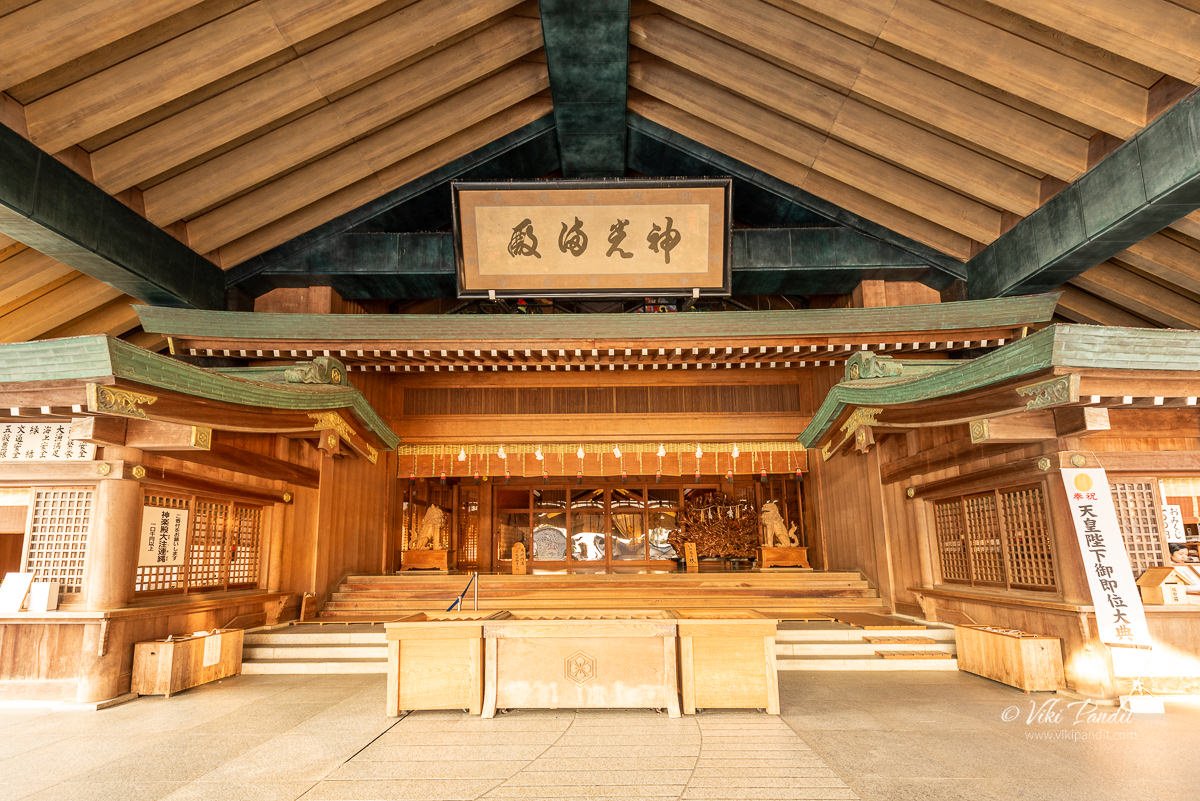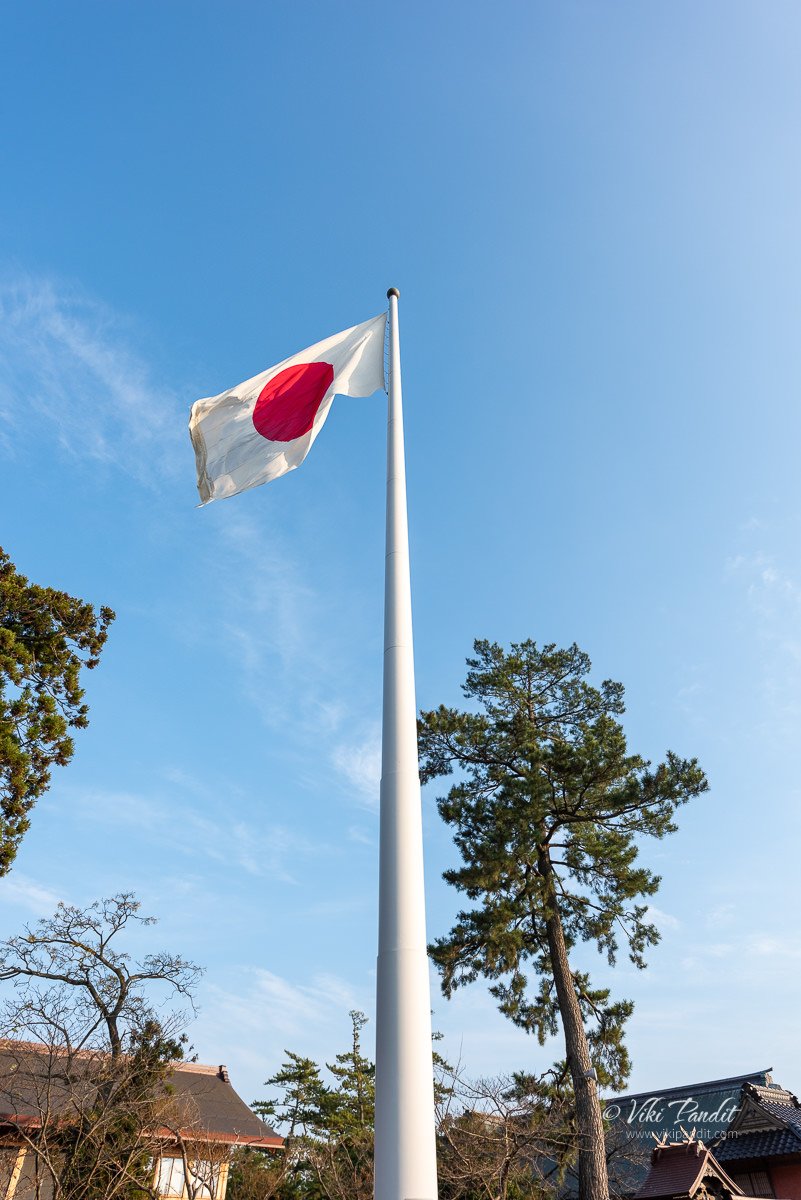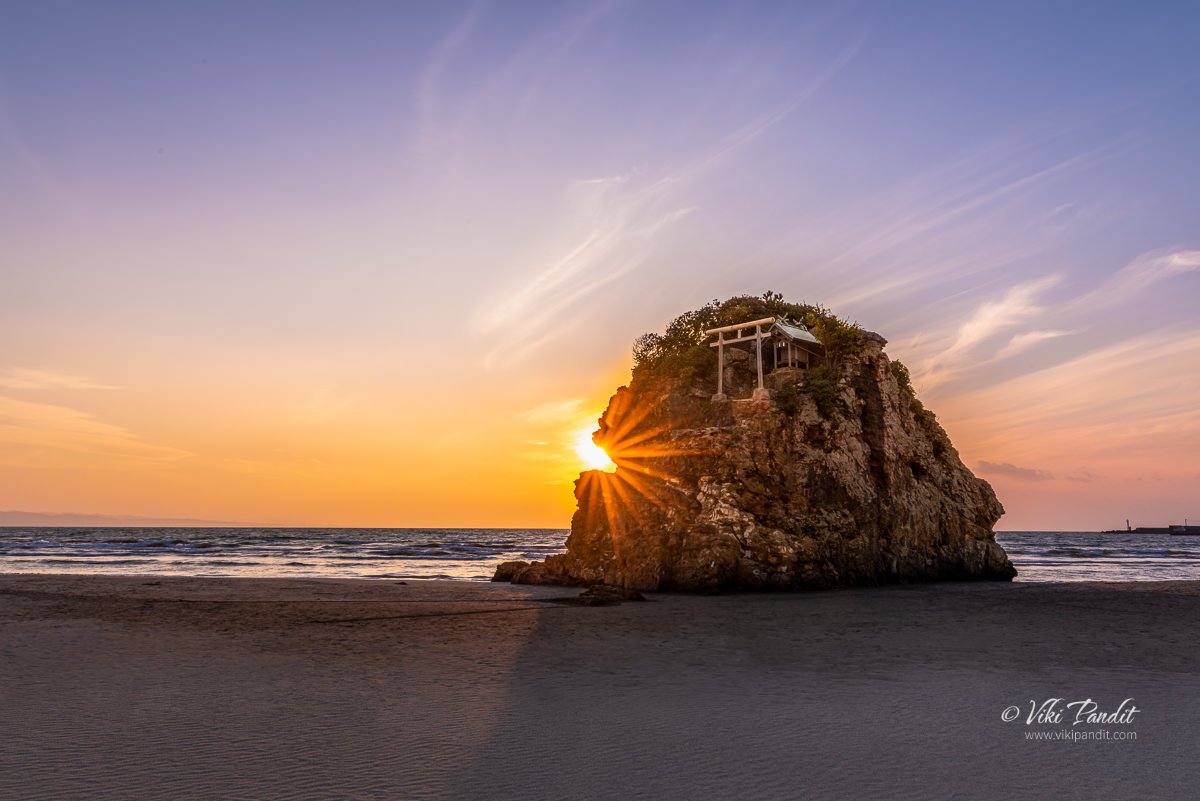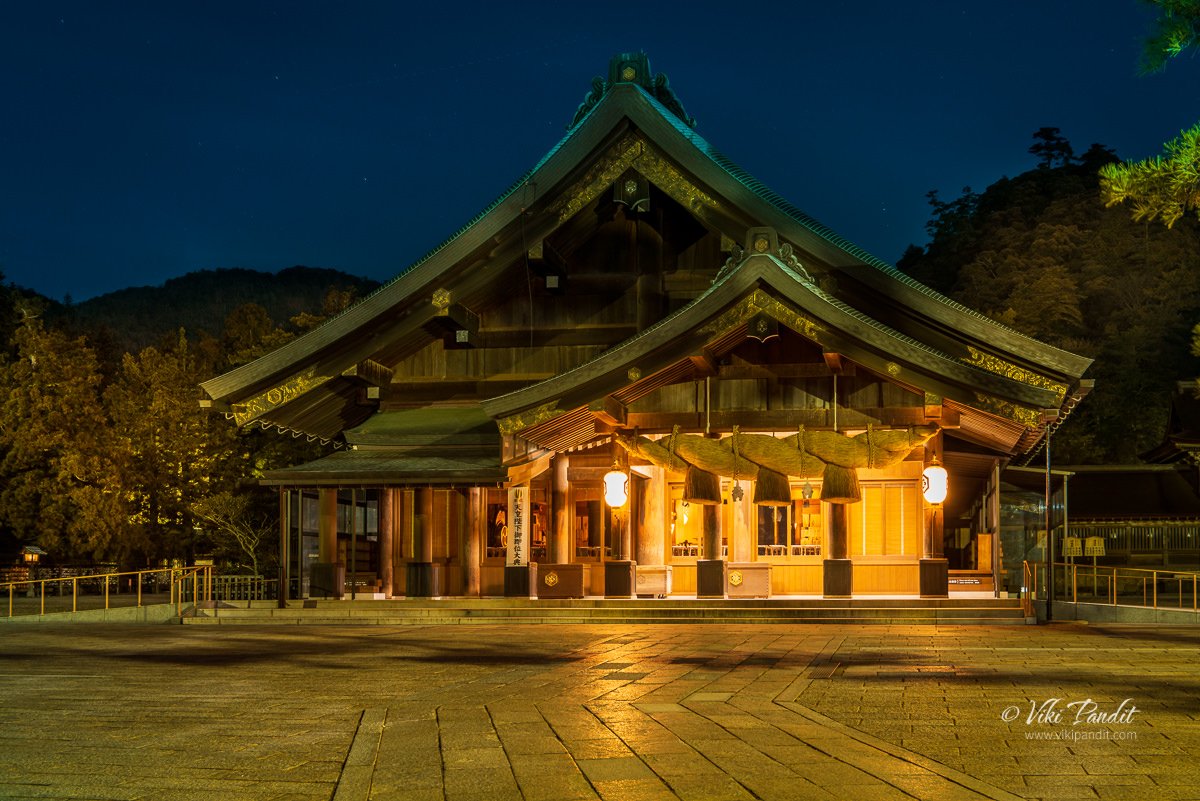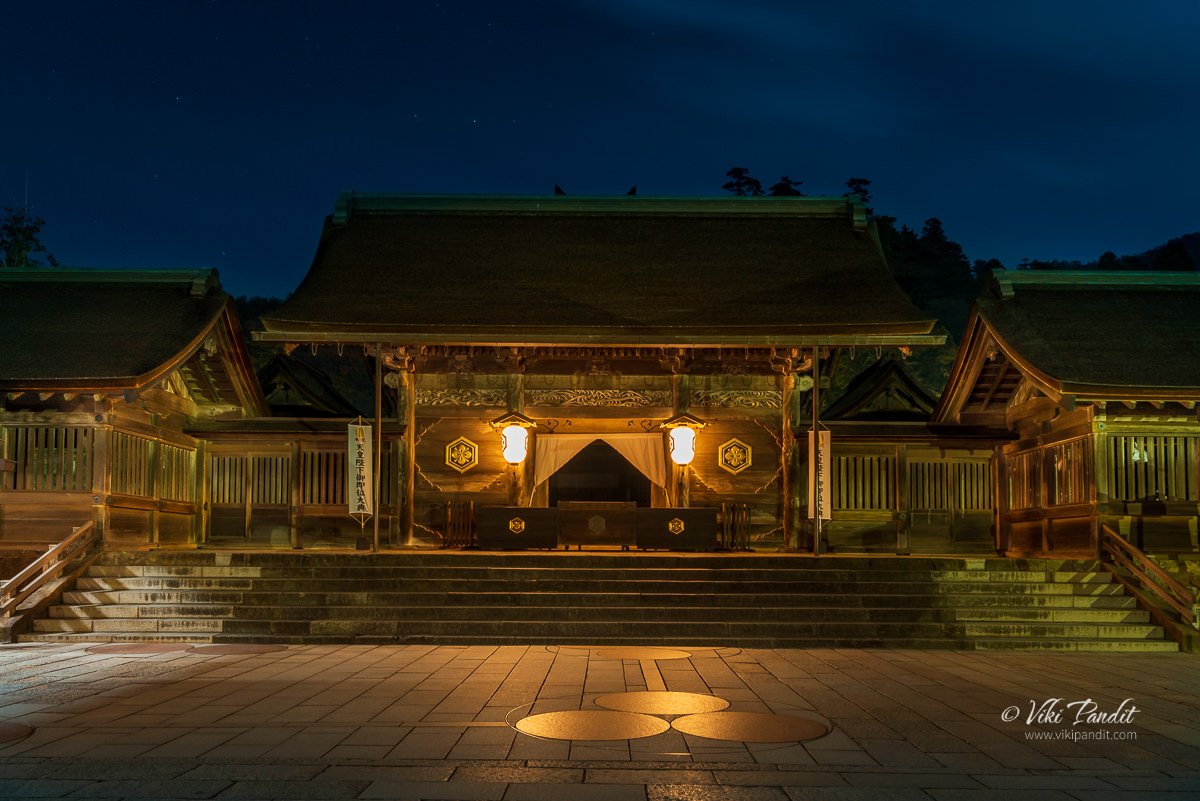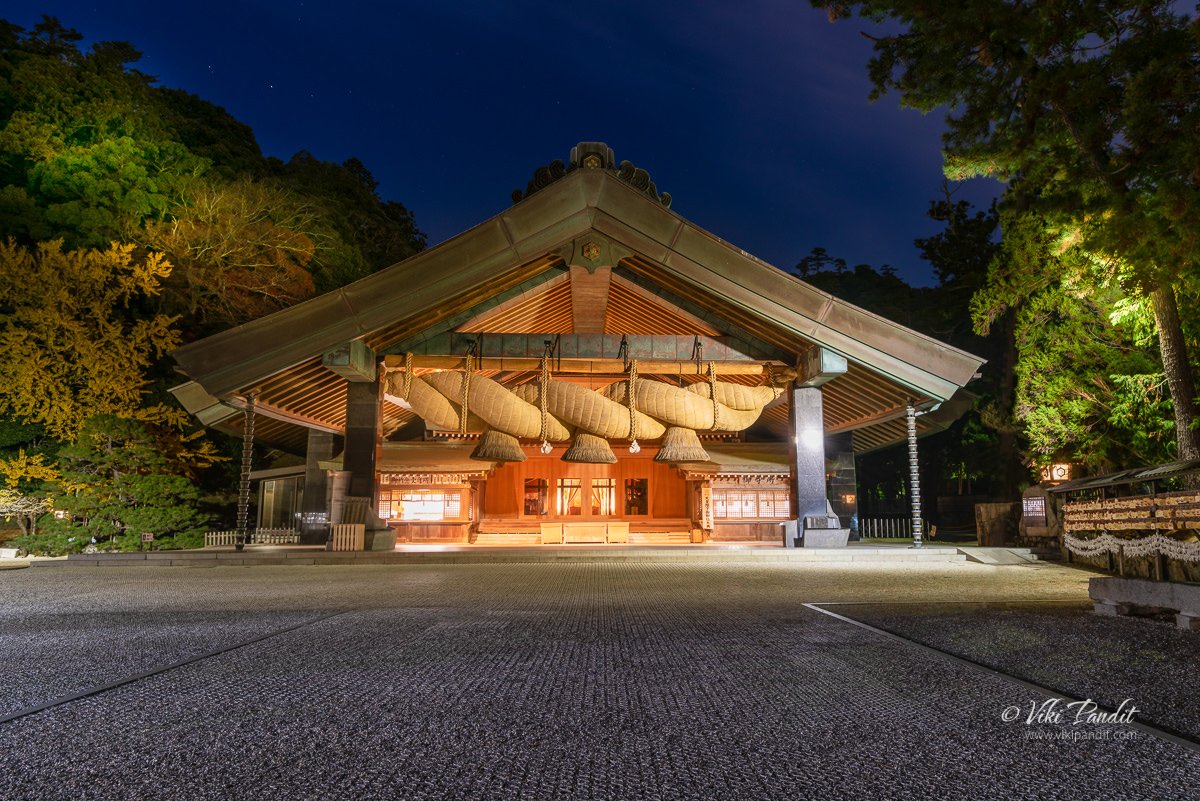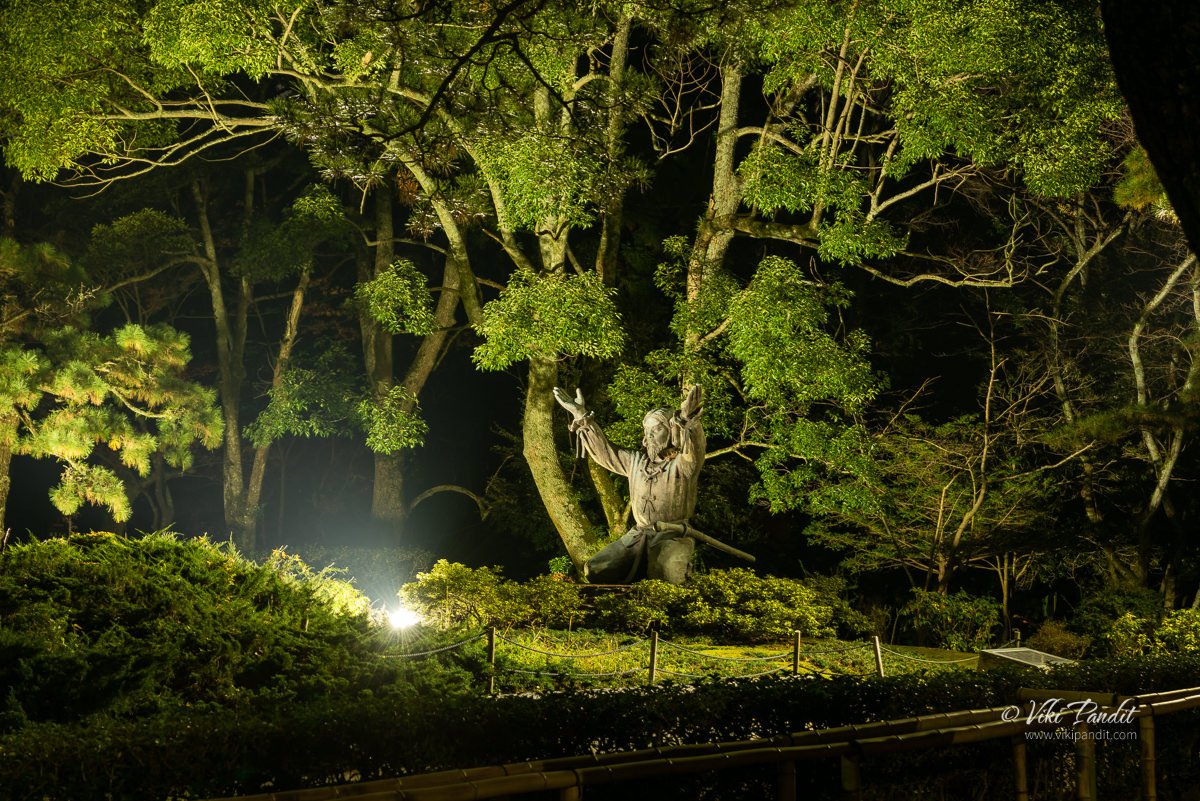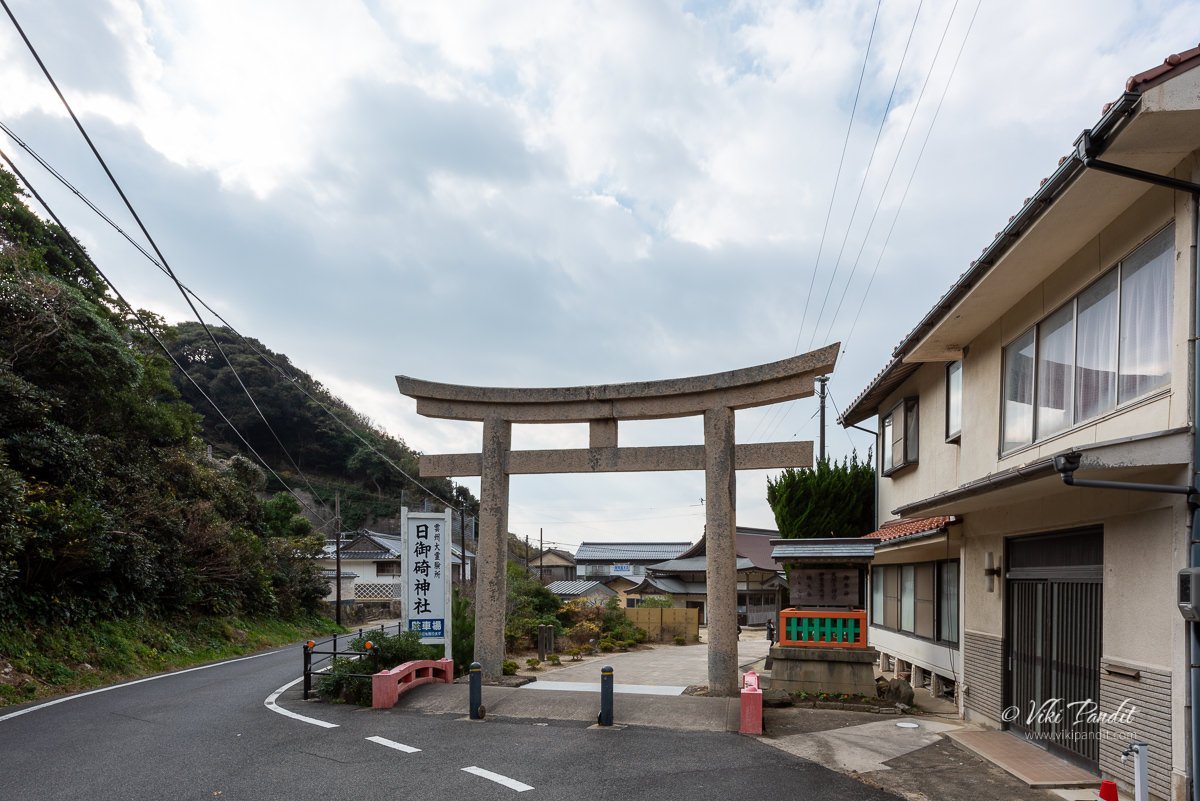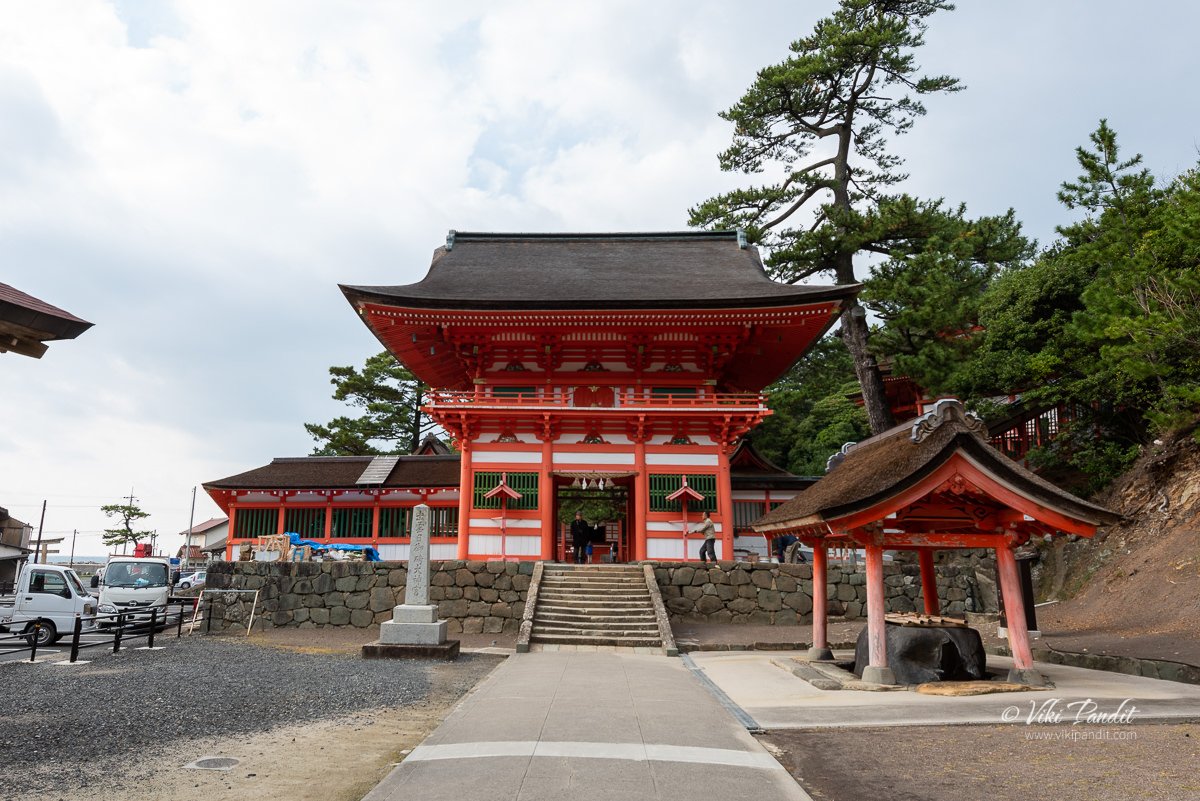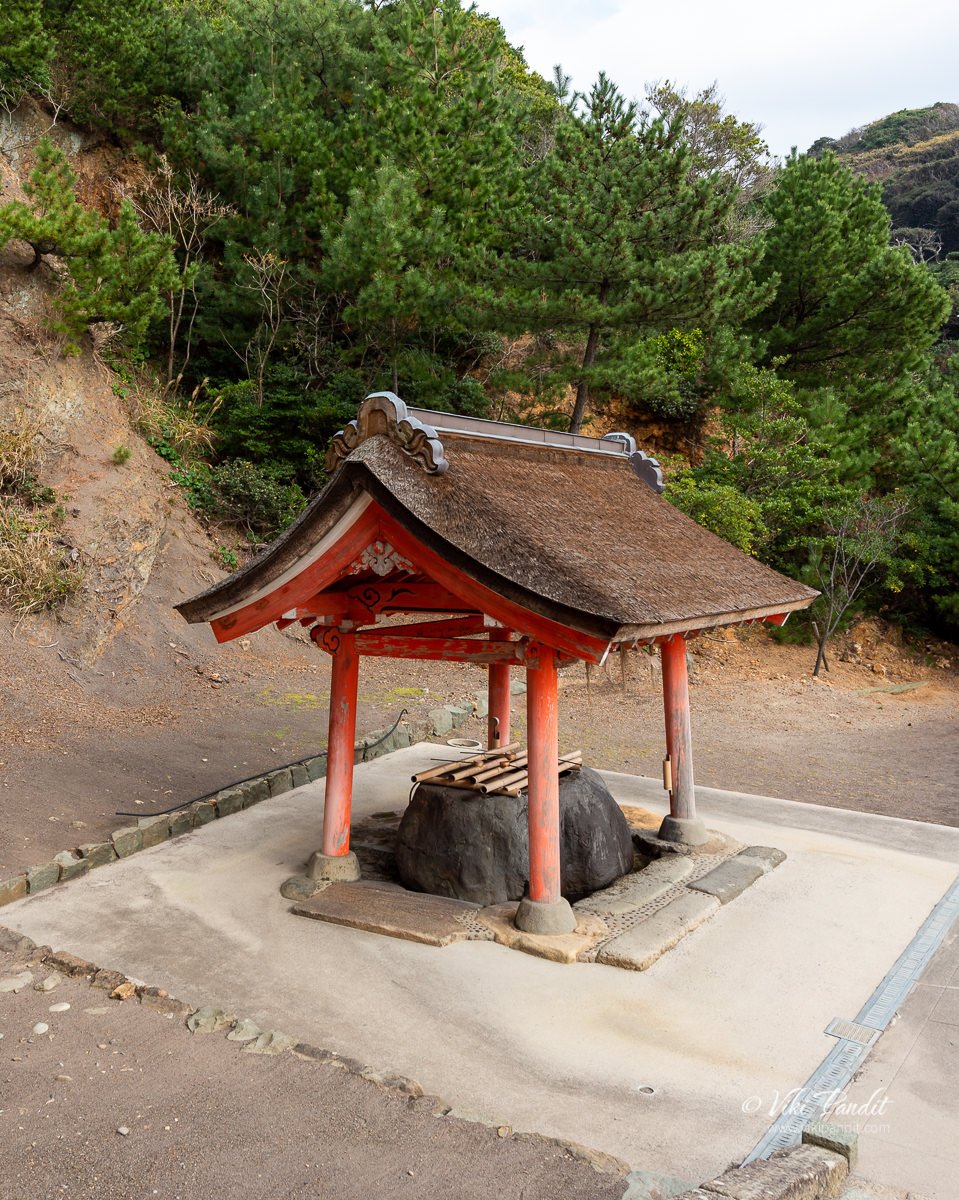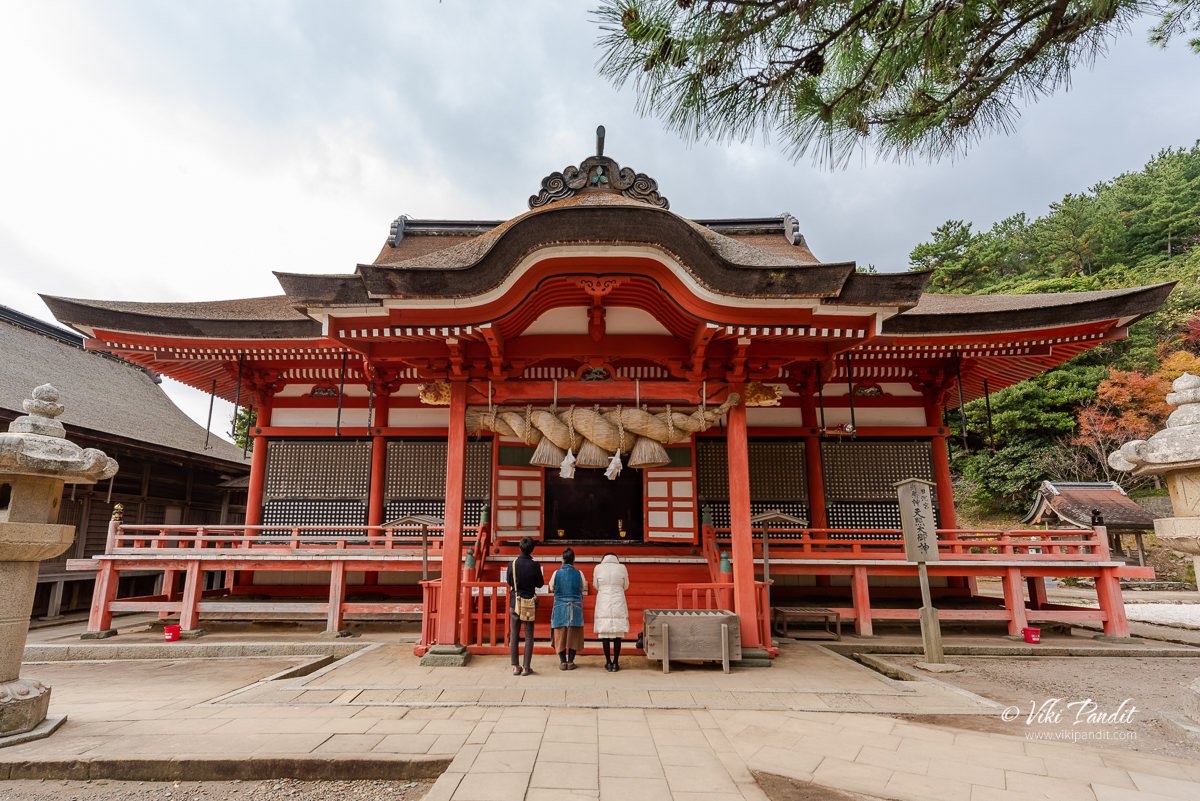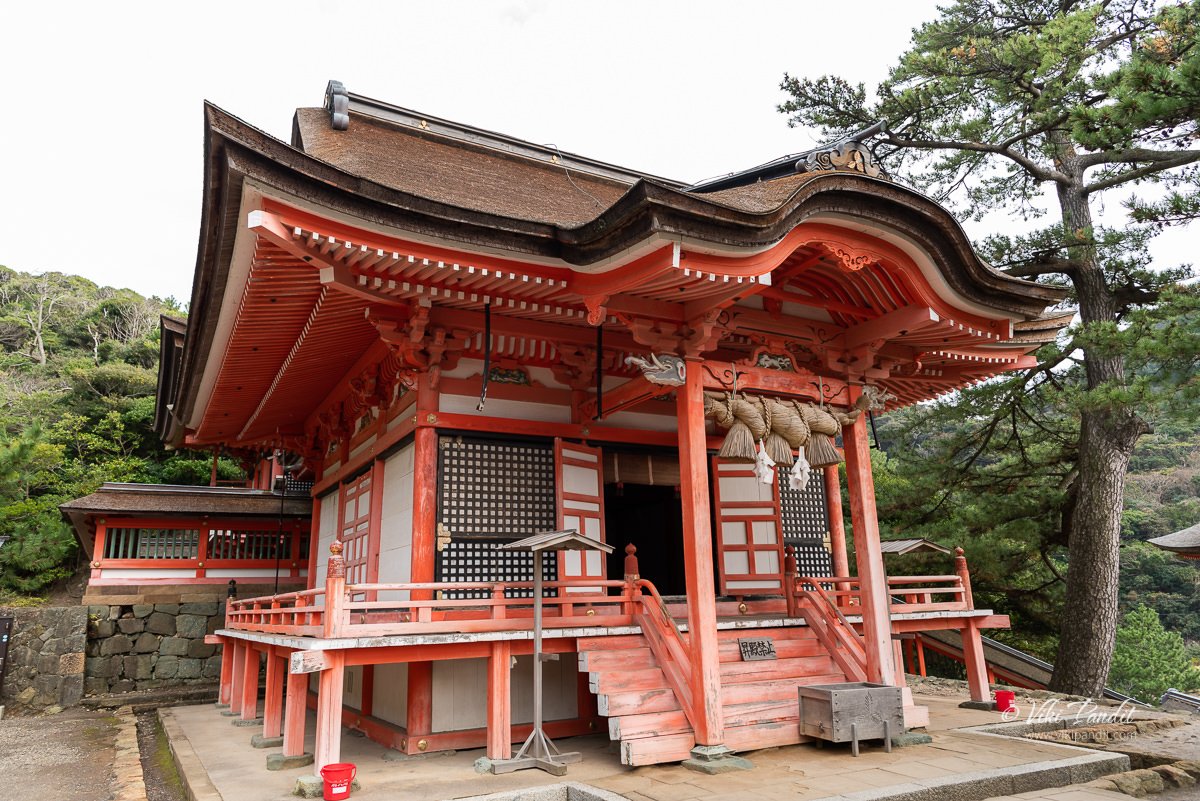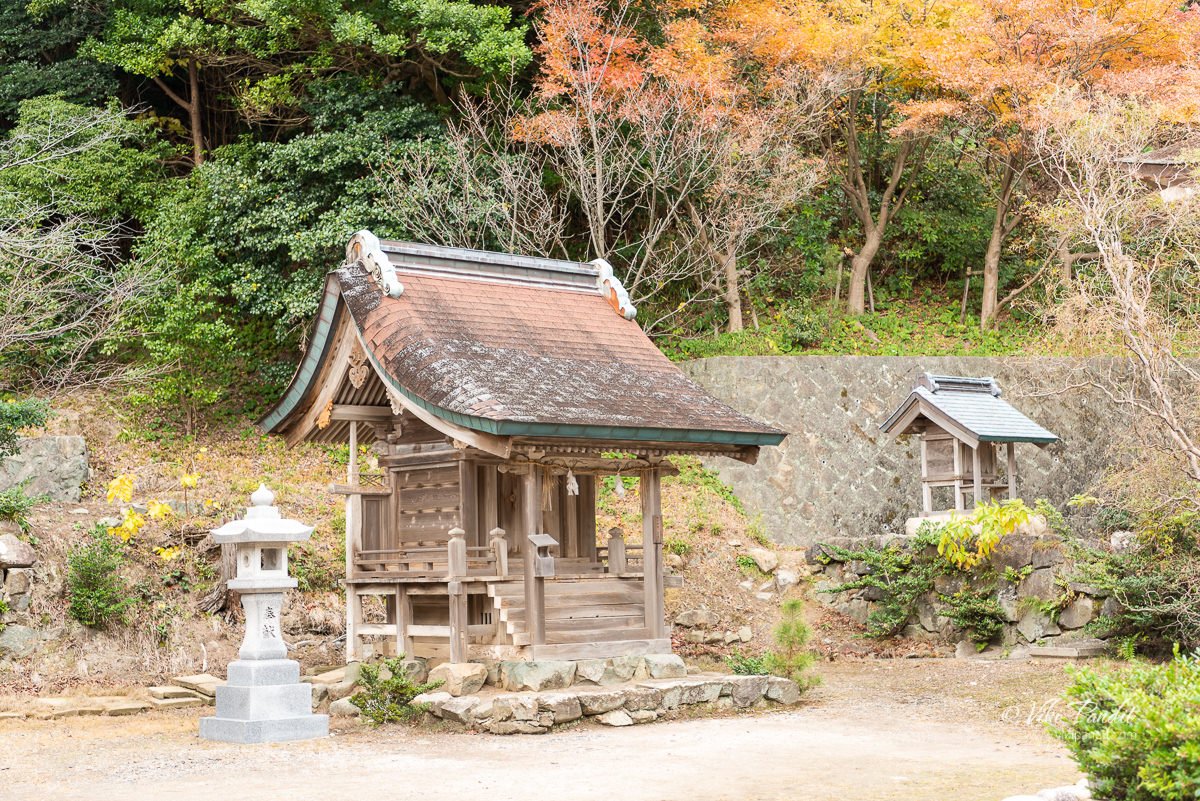Izumo-taisha, also known as Izumo Ōyashiro, is one of the most ancient and important Shinto shrines in Japan. No record gives the exact date of its establishment, but some of the oldest mythological stories of the country originate at this very place.
Located in Izumo of Shimane Prefecture, the shrine is dedicated to the god of nation-building, Okuninushi-no-okami, and it is said that, if you visit the shrine, you will have great luck when it comes to your love life and personal relationships.
How to reach Izumo-taisha
I and my wife, Mani, were staying at the Dormy Inn, just beside the Izumoshi Station. Dormy Inn is a nice place to stay in Izumo, with comfortable rooms and easy accessibility to local convenience stores.
This was my first visit to Izumo, primarily because the city is located on the extreme western edge of the Shimane peninsula, and it takes almost 4 hours to reach from Kyoto. I have been to Shimane before in 2016 when I visited the lovely Adachi gardens, but Izumo continued to remain on my bucket list.
The area surrounding Izumoshi Station is very quiet, unlike the bustling stations of Kyoto, Tokyo, or even Osaka. The town is literally littered with idols of Ōkuninushi, like the one below, which I saw on a roadside near the station. Ōkuninushi has had a massive impact on the history of Izumo, but we will delve into his story later on in this article.
It was 9 am in the morning. After a light breakfast of onigiris, we took the local bus to Izumo Taisha. Buses depart from bus stop #1 in front of Izumoshi Station roughly every 30 minutes. The one-way ride to the shrine takes about 25 minutes and costs ¥530.
The bus was mostly empty. I guess most travelers here are locals and they prefer their personal vehicles to travel. We had on us the “Enmusubi Perfect Ticket” which allows for a hassle-free travel on local buses. If you are in Izumo for a few days, I would recommend obtaining the “Perfect ticket” from the Izumo Tourist Information Center, inside JR Izumoshi Station.
This ticket costs ¥1500 per adult and entitles you unlimited free rides on local trains and buses for 3 consecutive days. The ticket also includes discounts and certain special privileges at a few tourist spots.
You can also take the local Ichibata train to the shrine, but it will likely take up more time as it involves changing trains midway at Kawato Station.
The red and white bus dropped us off near a large grey colored Torii gate that marks the beginning of the walk to the heritage shrine. A Torii is the symbol of a Shinto Shrine. It marks the entry into the sacred grounds of the Shrine. Four Toriis in total need to be passed before reaching the Izumo Taisha shrine and each is made of a different material: stone, wood, iron, and copper (in order from the first to fourth). We missed the first Torii since the bus went past it and dropped us off near the second one. If you are interested, you can walk back to the white torii, made of stone. In ancient times, it used to be the original entrance gate to the shrine.
From the wooden torii, a wide paved path leads visitors towards the shrine grounds. Along the way, you will find many stone lanterns like the one below. Moss had gathered around the top and the base. The detailing in the carving of the lantern will tell you that its made for Kimachi stones located near Lake Shinji.
Myths surrounding Izumo Taisha
Before I show you the age-old structures inside the Izumo Taisha complex, let me explain to you some of the myths surrounding this heritage site. Like most cultures, the Japanese also have their own interesting take on the origins of their country. The Shinto myths originating from Japan can be segregated into four eras. Izumo Taisha originates from the first – the mythical era of the heavenly and earthly kami. Kami are basically the spirits, gods, and deities in the Shinto religion. The gods were divided into Amatsu-kami (heavenly gods) and Kunitsu-kami (earthly gods.)
All my conclusions have been drawn from two of the oldest written records in Japan – Kojiki (the legendary stories of old Japan) and Nihon shoki (the chronicles of old Japan). The myths of Izumo represent their own cycle in these classical works, which have several discrepancies with the Yamato myth cycles which mainly concentrated on the tradition of the imperial family and repeatedly tried to downplay the importance of the stories originating from Izumo.
According to the Kojiki; Heaven and Earth were created in this era referred to as the mythical era. The Earth itself at that time was said to be just a formless ocean with no landmass. In the beginning, as is mentioned in Kojiki – five deities came into existence at the time of the creation of the universe, called the Kotoamatsukami. Unlike the later gods, these deities were born without any procreation. The Kojiki further portrays the birth of Inazagi-no-mikoto and his younger twin sister Izanami-no-mikoto as the seventh and final generation of deities that manifested after the emergence of the first group of gods. Together they are considered to be the patriarch and matriarch of all other Japanese gods.
Receiving a command from the other gods to solidify and shape the earth, the couple, with a jeweled spear, standing on the heavenly floating bridge that connected the Heaven to Earth, stirred the watery chaos of the ocean depths. As they raised the spear, it is said, brine that dripped from the tip fell to form solid islands, that together formed the archipelago of Japan.
The two then proceeded to have many children. Izanami, however, died after giving birth to the fire god Kagutsuchi. Izanagi, wishing to see Izanami again, goes down to Yomi no Kuni, the land of the dead, in the hopes of retrieving her, but fails.
On returning back, Izanagi, feeling contaminated by his visit to Yomi no Kuni, went to the river-mouth of Tachibana in Himuka to purify himself. As he immersed himself in the water, various deities came into existence. The three most important kami – the sun goddess Amaterasu Ōmikami, the moon deity Tsukuyomi-no-Mikoto, and the impetuous god Susanoo-no-Mikoto – were also born here.
At this time a depressed Izanagi, said, “I have borne child after child, and finally in the last bearing I have obtained three noble children.” Then he goes on to remove his necklace and, giving it to Amaterasu, he entrusted her with her mission, saying, “You shall rule Takama-no-hara, the dwelling place of the heavenly gods.”
Next, he said to Tsukuyomi, “You shall rule the realms of the night.” Finally, he turned to Susanoo, entrusting him with his mission, “You shall rule the ocean.”
The Kojiki states that the world where the people lived is called Ashihara no Nakatsukuni, while the realm of the dead which was believed to exist inside the earth is called Yomi no Kuni.
While the other deities ruled their realms in obedience to the commands entrusted to them, Susanoo did not rule the land entrusted to him. Instead, he wept and howled until his beard extended down over his chest. It is said, the prolonged mourning Susano-o displayed for his mother Izanami, turned green mountains barren. His weeping was such that it caused the rivers and seas to dry up.
In a well-known sequence from that myth-history, the Kojiki relates how the god Susanoo was banished by decree of his father, Izanagi. During his mourning, he committed numerous transgressions like destroying Amaterasu’s rice fields, desecrating the hall where Amaterasu was to taste the first rice, and interrupting the weaving of heavenly garments.
On coming to know of Susano-o’s transgressions, Izanagi asked Susanoo, “Why is it you do not rule the land entrusted to you but weep and howl?” Susanoo replied, “I wish to go the land of my mother.”
On hearing his reply Izanagi, became greatly enraged and said, “In that case, you may not live in this land!” Thus saying, he banished him with a divine banishment to rule over Yomi no Kuni, the realm of the dead on Earth.
Following his banishment, the Kojiki recounts Susano-o’s descent from the Heavenly Plain to the ancient province of Izumo, where his character undergoes a dramatic shift. He resigned himself to his fate and eventually after many wanderings on Earth, built a magnificent palace in Izumo, at Suga. Under his leadership, the Japanese islands came to be controlled from Izumo. Izumo came to be known as the realm of gods on Earth.
Susanoo lived in Suga with his wife and had many children. One of his descendants was Okuninushi. Okuninushi had eighty brothers and was always reckoned to be the least among them. How he came to rule these lands from being one of the most unworthy among his siblings is another interesting story.
It should be noted that the Kojiki and Nihon Shoki – compiled at different moments, in different linguistic modes, and with different sources and audiences in mind contradict each other on various fundamental points.
As we continued our walk towards the shrine, we were surrounded by tall pine trees that were hundreds of years old. In order to protect these ancient trees, visitors are not permitted to walk through the central pathway. The third Torii lies at the start of these pine trees. We took an adjacent path that led us into a wide, open area from where we could see Mt. Yakumo clearly.
At the end of the trail we found a small stone torii. This is the shrine of Kinazuki Forest. Interestingly there is no shrine after the torii. The forested area is itself considered a shrine.
It is said in the old days, the gods of Takama-no-hara gathered in this place to build the “Sunshine Palace“, the predecessor of Izumo Taisha. At the time of construction, the gods used a “pine” to beat wood and solidify the ground. This “pine” used by the gods is said to be still buried deep in the ground of this forest. This torii gate was built and worshiped as a place where tools used by the gods are buried.
The story of Okininushi
As we neared the fourth torii, that leads directly into the innermost shrine grounds, we found the temizuya, or ritual cleansing place where you should stop and wash your hands.
Near the Temizuya, you can find a statue of Okuninushi and what looks like a giant wave with an orb balance on it. This statue is a more artistic depiction when Okuninushi met Omono-nushi, represented by the gold orb on top of the wave. This is an important moment in the mythology of Okuninushi because at this moment he realized that he had the support of the heavenly gods.
The main god worshiped at Izumo Taisha is Okuninushi-no-Okami, who is also well known in Japan as Daikoku-sama.
Okinunishi married several times and had many children. The procreative actions of Okinunishi created alarm bells ringing as their descendants started taking over Earth. Amaterasu, who was still the ruler of heaven, taking displeasure at this act sent deities down to pacify and subdue the land, which was being overrun by unruly and troublesome divinities.
The initial attempts to subdue the unruly divinities ended in failure, as the first deities sent down from Takamahara ended up allying with Okuninushi instead. On her third attempt to dissuade Okuninushi, the heavenly deities decided to send a powerful warrior Takemikazuchi-no-kami who descended on Inaba beach in Izumo. Only after the deity Takemikazuchino descends and is about to kill Okuninushi’s son did he agree to surrender the land to Amaterasu’s envoys.
In exchange for his submission, Okuninushi received recognition for his own status as the deity of the great shrine of Izumo. As a sign of gratitude, Amaterasu let him retain dominion over the religious and magical world.
According to the Nihon Shoki, the goddess Amaterasu said, “From now on, my descendants shall administer the affairs of state. You shall cast a spell of establishing a good relationship over people to lead them a happy life. I will build your residence with colossal columns and thick and broad planks in the same architectural style as mine and name it Amenohisu-no-miya.”
After the subjugation of Okuninushi, a crucial episode in the imperial legitimation follows. Okuninushi resigned and retreated into his palace in Kizuki. Amaterasu assigned her grandchild Ninigi to descend to Earth and take over the rule. Thereafter no other lineage than that of the sun goddess was to hold the sovereignty. The Gods of the Izumo line were thereby downgraded for all times into a subordinated position. The end of the mythical era thus sees the earthen kami subdued by the heavenly kami.
As per her deal with Okuninushi, the other gods were gathered and ordered by Amaterasu to build a grand palace at the foot of Mt. Uga. I used the term palace, do not be confused by it, I am still referring to Izumo-taisha. Izumo-taisha has been known by various names in the past: Sunshine Palace → Kizuki Taisha Shrine → Izumo Taisha Shrine
Since then, couples and sweethearts both young and old have made the pilgrimage together to pray at the temple for good fortune and long lasting commitment. This connection of the divinity to love and sexuality is preserved in the corresponding religious traditions. Okuninushi, the great God of Izumo, today is as popular as he was in the past – as Enmusubi no kami, the divinity of the fateful bonds of love between two people. The belief traveled miles over the years and is now known all over Japan for bestowing fortunate marriage.
As with all mythological stories there are variations and they should be just consumed as a story and nothing else.
Brief history of Izumo taisha
There is no knowledge of exactly when Izumo-taisha was built, but a record compiled around 950 CE (Heian period) describes the shrine as the highest building, reaching approximately 48 meters, which even exceeded in height the 45 meter-tall temple in Nara that enshrined the Great Buddha of Tōdai-ji. A gigantic ramp is said to have led to the shrine building.
There exists a book named “Kuchizusami“, that recorded the names of the famous rivers, long bridges, great buildings, or any other major landmarks in Japan. In the book, one of the phrases mentions “Izumo is the top, followed by Yamato, then by Kyoto”. It could have been in reference to the height of the buildings in Japan at that time, the main building of the Izumo Grand Shrine was number one; the hall for the Great Buddha figure of Todai-ji temple in Yamato (present Nara) was second, and Daigokuden Palace in Heiankyo (Kyoto) was the third in height.
The document from the 10th century, indicate that the highest building in the complex was around 48 meters and stood on 9 massive columns. To reach the temple there was probably a massive flight of steps as well. Excavations have confirmed its probable existence.
Posters with illustrations of this reconstruction can be found throughout the region; they show an archaic shrine, embedded in a mystical scenery. The message of such pictures is clear: The main shrine of Izumo was in antiquity not only the tallest building of Japan – but it was also always stressed that this building was higher than the Todaiji in Nara.
The colossal size of Izumo shrine was quite literally also its downfall as it collapsed on its own weight multiple times in the 11th and 12th centuries.
Up to the Meiji Era, Izumo Taisha was called Kizuki Grand Shrine.
During the Kamakura period, around 1200, the main structure was reduced in size. Then in 1744, the shrine was reconstructed to the present size of 24 meters high and 11 meters square at its base. In the 18th and 19th centuries, as travel became more common in Japan, the shrine became a central place of pilgrimage.
Since the shrine spirit was settled in the inner shrine in 1744, it has been relocated three times for renovation, using a traditional ceremony. The relocations took place in 1809, 1881, and 1953. From 1871 through 1946, the Izumo-taisha was officially designated one of the Kanpei-taisha, meaning that it stood in the first rank of government supported shrines.
In April 2008, the spirit was moved to temporary housing in the front shrine of Izumo-taisha in preparation for the Heisei-period renovations. Izumo-taisha’s inner shrine was opened to the public for the first time in 60 years in the summer of 2008. On completion of the renovations, Ōkuninushi was returned to the inner shrine in a ceremony attended by over 8,000 people, held on May 11, 2013.
Inner area of Izumo Taisha
Let me quickly share a map of the grounds so its simpler for you to follow. The red rectangular text blurb is where the temizuya is.
Haiden
When you go through the fourth copper Torii, you will see the Haiden, where visitors in general pray. The Haiden (prayer hall) will be the first visiting point for most people. It was re-built in 1959 after the end of the Second World War. The prayer hall holds an impressive three-ton Shimenawa, made of rice straw. A Saisen-bako (money offering box) lies in front of the gate.
I have heard that throwing a coin into the Shimenawa will bring luck, if the coin gets stuck in it. However, I didn’t observe anyone doing it so I too reclused myself from doing it.
Although it is usual to bow twice, clap twice, pray, then bow once more at Shinto shrines, the practice at Izumo-taisha is to bow twice, clap four times, pray, and bow once more.
The Haiden is often directly connected with the Honden. In the case of Izumo Taisha Grand Shrine, the Haiden is standing on its own. In its role as a prayer hall, it is used to pray to the kami of the shrine and also host a variety of ceremonies.
Yatsuashi-mon
Just beyond the Haiden, you will find the Honden, or main shrine, where a statue of Okuninushi resides. Okuninushi is worshiped at the shrine as the deity of nation-building, but, more popularly, also as the deity of ‘en‘, or the ties that bind us to each other.
The main shrine is enclosed inside the Yatsuashi-mon gate, with only a portion of its roof visible from outside. The Yatsuashi-mon is an eight-columned gate, the front of which is occupied with another Saisen-bako. The main shrine was built using one of Japan’s oldest shrine architectural styles, the Taisha-dzuki method, and is recognized as a Japanese National Treasure. This area is surrounded by two sets of Mizugaki (fence).
I was not allowed entry to the inner-shrine precinct. From what I gather, it can be only entered by priests and Miko. An exception is the New Year when during Hatsumode, the Saisen-bako is moved closer to the Honden and visitors can step through the gate.
Standing in front of the Honden, I bowed and then clapped my hands four times, instead of the two that is the standard ritual at Japanese shrines. Clapping twice is believed to get the attention of the gods, but since Okinunishi is the deity of relationships, at Izumo Taisha you need to add a couple of claps for your significant other.
Worshipers are not permitted inside the Honden except on special occasions.
We walked around the sprawling complex. Long rectangular buildings with shuttered entrances lined either side of the Honden. In front of the small structures, you can see hundreds if not thousands of omikuji tied to the trees and makeshift wooden panels. If you are a souvenir collector, you can buy amulets created from a hinoki cypress tree that used to support the shrine.
If you’d like to, you can also purchase an ema at the shrine here. The small wooden plaques are a way to write down your prayers or wishes, and by leaving them at the shrine, the gods are believed to be able to receive them. It’s always interesting to have a look and see what people are wishing for at different shrines.
Nishi-jukusha
According to an age-old myth, it is said that various gods gathered together at Izumo in the 10th month of the old Japanese lunar calendar. October is thus referred to as Kannazuki, or the “month of no gods” throughout most of Japan. During this time, Okuninushi, is said to summon all earthly deities to decide the fate of all people for the year ahead. For this reason, this month in Shimane Prefecture alone is known as Kamiarizuki – the “month of the gods.”
The row of wooden structures you see below called Jukyusha, are the said to the rooms where the various deities gather and stay during their visit to the shrine.
As we made our way towards the back area, we found ourselves in front of the Shōkokan.
Shōkokan
The Shōkokan consists of two floors. The first floor is the reception office for Kaguraden. The second floor consists of a museum for important items. Unfortunately it was closed at the time of our visit.
Some items in the museum are items designated as national treasure and important cultural assets, like jewelry, household articles, paintings, swords, and musical instruments.
Considered most important in Shōkokan are a set of Japan’s oldest wooden pestle and an igniting board and a small boat that was hollowed out of a piece of wood. The small boat was believed to have come from the upper stream of the Yoshino River, through the Seto Inland Sea, and to the Inasa Beach near Izumo-taisha.
Soga-no Yashiro
A few paces beside the Shōkokan, you can find the Soga-no Yashiro shrine, standing exactly behind the main hall, almost enveloped by the forest at the base of Mt. Yakumo. This shrine is dedicated to Susanoo.
On the right side of the shrine, you will find a tray filled with sand. According to Shinto practice, many shrines in the Shikoku and Chūgoku regions, called Izumo yashiki, were purified with small quantities of sand taken from under the floor of this shrine.
If you take some of Soga no Yashiro’s sand with you and place it around your house, it will protect your home.
In front of Soga-no Yashiro you will find a bunch of rabbit idols. According to legend, Okuninushi once saved a rabbit, which is why you will find many cute rabbit statues at Izumo Taisha.
From Soga-no Yashiro, we completed a full circle of the walkway surrounding the main hall. From there we slowly made our way towards the Kagura Hall, which is one of the most photographed shrine on the complex.
Kagura Hall
Izumo-taisha’s Kagura-den was first built in 1776 by the Senge family, as a grand hall for the performance of traditional rituals. It was rebuilt in 1981 to commemorate the centennial of the foundation of the Izumo Oyashiro-kyo order.
The written sign inside Kagura-den is not made with ink, but it’s in fact embroidery. You will see the cross-stitch style if you look closely. There is also a stained glass with pictures of clouds in the shape of Izumo Taisha.
The Kagura-den features the largest shimenawa (sacred straw rope) in Japan. The rope is one of the most easily recognized and distinctive features of Izumo-taisha. The shimenawa is 13.5 meters long and weighs 4.4 tons, making it one of the biggest in Japan. You are sure to be surprised at the sheer scale of this straw rope hanging a few feet above your head.
A few feet away from the Kagura-den you can see a huge Japanese flag swaying in the wind.
After fully exploring the area we walked down to capture the stunning sunset at the Inasahama beach where in a few months the gods would be greeted again for the first day of “Kamiarizuki.”
The sun was just setting behind a veil of violet-hued clouds, and the wide beach was empty save for a few local teenagers and a couple busy with their pre-wedding photo shoot. As the daylight sunk bank into the horizon, we walked back to Izumo Taisha. The road devoid of any streetlights gets pretty dark and we did have some difficulty walking back to the shrine.
Once we reached the shrine, we found ourselves all alone on the massive grounds. A lone guard, neatly dressed in his “royal blue” attire, was standing guard on the premises. I politely asked him if I could use my tripod on the shrine grounds. In a very simple gesture of touching the index finger with his thumb, he gestured that it was okay. I took a couple of pictures of the Haiden, and then walked briskly to the Yatsuashi-mon gate.
Yatsuashi-mon at night
It was a bit eerie around on the grounds with not a soul in sight, but it was also easy on me as I took some lovely night shots of the gate without any photobombs getting in the way.
Kagura-den at Night
Lastly, I captured some shots of the Kagura hall which was looking immersive in the beautiful blue night. Once I had my fill of night shots, we made our way towards the bus stop.
On the way, the Okinunishi’s statue was sitting beautifully illuminated in the night. While the area is mostly unexplored by foreigners, it’s very popular with the Japanese, many of whom arrange to spend summer vacations in this region known for the relatively unspoiled, rugged beauty of its countryside and the relaxed pace and cultural riches of its towns.
Once we reached the iron torii at the edge of the shrine grounds we waited for the next bus, sitting on a roadside bench in front of a lively Starbucks.
Izumo Grand Shrine is one of the most recognized shrines in Japan, and attracts more than 2 million visitors every year. This historic temple is such a valued landmark, that you’ll see some of its architectural elements copied and utilized on the exterior entrances of various restaurants, bars, and shops in the city.
It’s recommended that the best time to visit is in the month of October when a large festival takes place to commemorate the meeting of Japan’s deities within the city of Izumo. If you can’t make the October festivals, you can still take part in a special tradition called shiokumi that is held on the first of every month. In the early morning, you take water from the sea with a special bamboo container. Then, you walk to Izumo Taisha stopping at all the shrines along the way.
Thanks for reading! If you liked my story, please add a comment below or follow my travels as I visit the only original castle remaining in the San’in region – Matsue Castle.
Unknown. The first written records compiled around 950 CE describes the shrine as the highest building in the region.
Kojiki is Japan’s oldest book, which was presented to the Emperor of Japan in 712 CE. It is said that a group of government officials of the Imperial court led by Oono Asomi Yasumaro compiled the book based on traditional folklore. The original copy no longer exists, but several manuscripts have been passed down over the ages. Most historical events, myths, and legends from the beginning of the Japanese civilization up to the era of Japan’s first empress, Empress Suiko in the early 7th century, are presumed to be recorded here.
Nihon Shoki is Japan’s oldest official history, established in the Nara period in the 8th century. It was compiled by a group led by Prince Toneri of the Imperial family and was completed in the year 720 CE. It writes about events of early Japanese mythology up to the era of Emperor Jito to the end of the 7th century.
Bow twice deeply with hands placed around your knees, then clap four times, praying silently, and finally bow once again for the last time. Worshipers may recite this short prayer while praying :
“Saki-Mitama, Kushi-Mitama, Mamori-Tamae, Sakihae-Tamae”
Free
Always open
Yen 300
8:30 to 16:30
